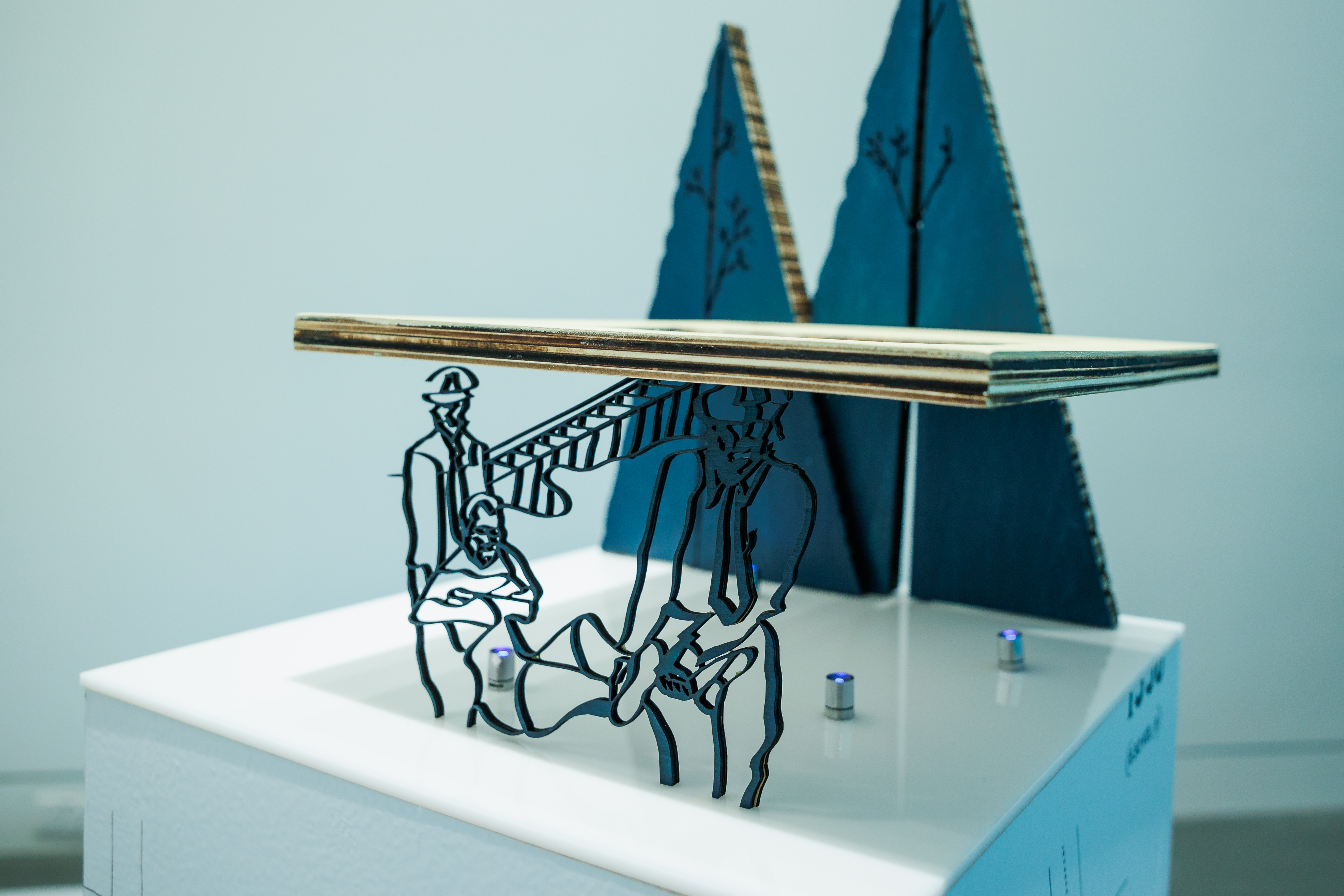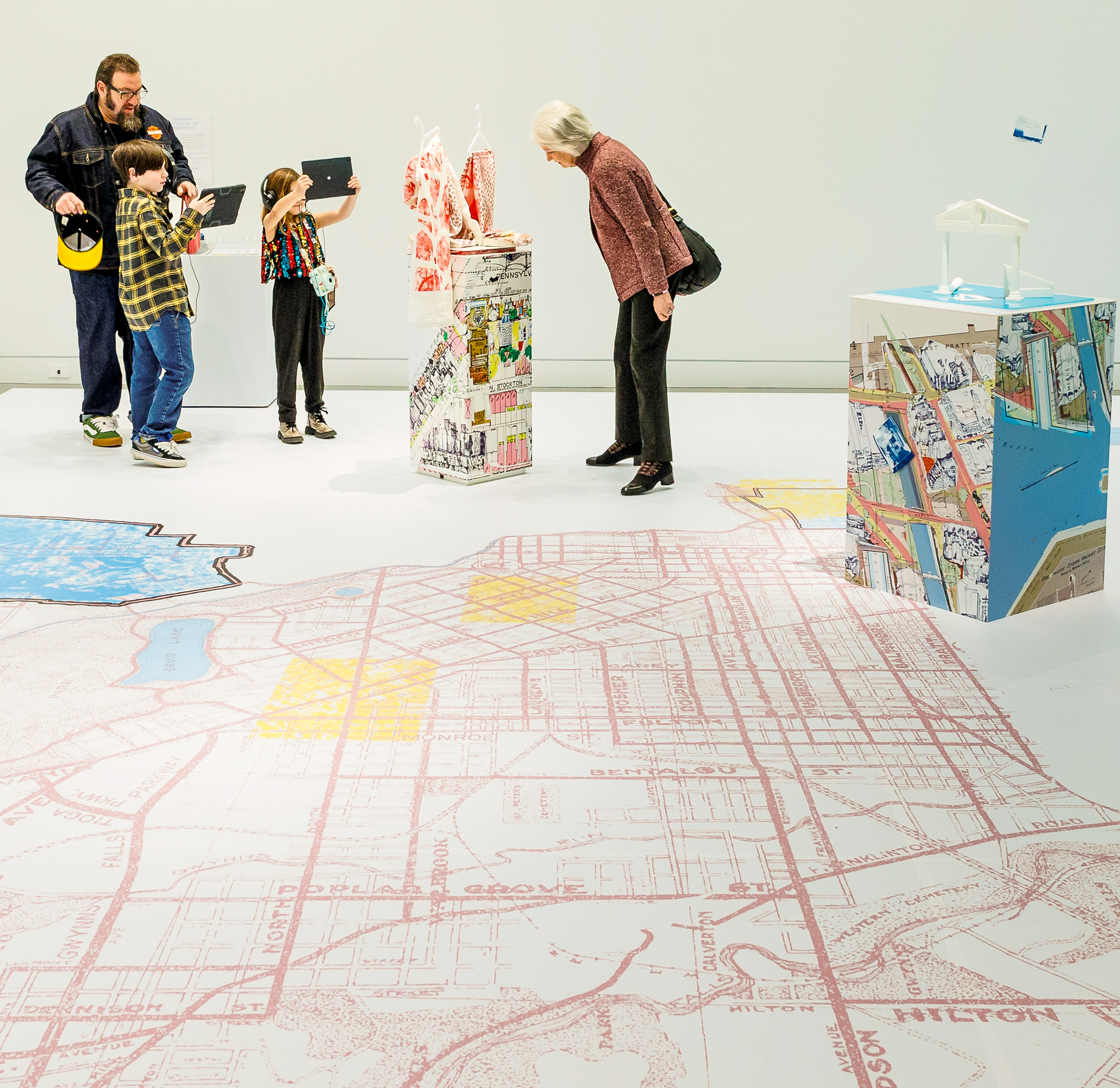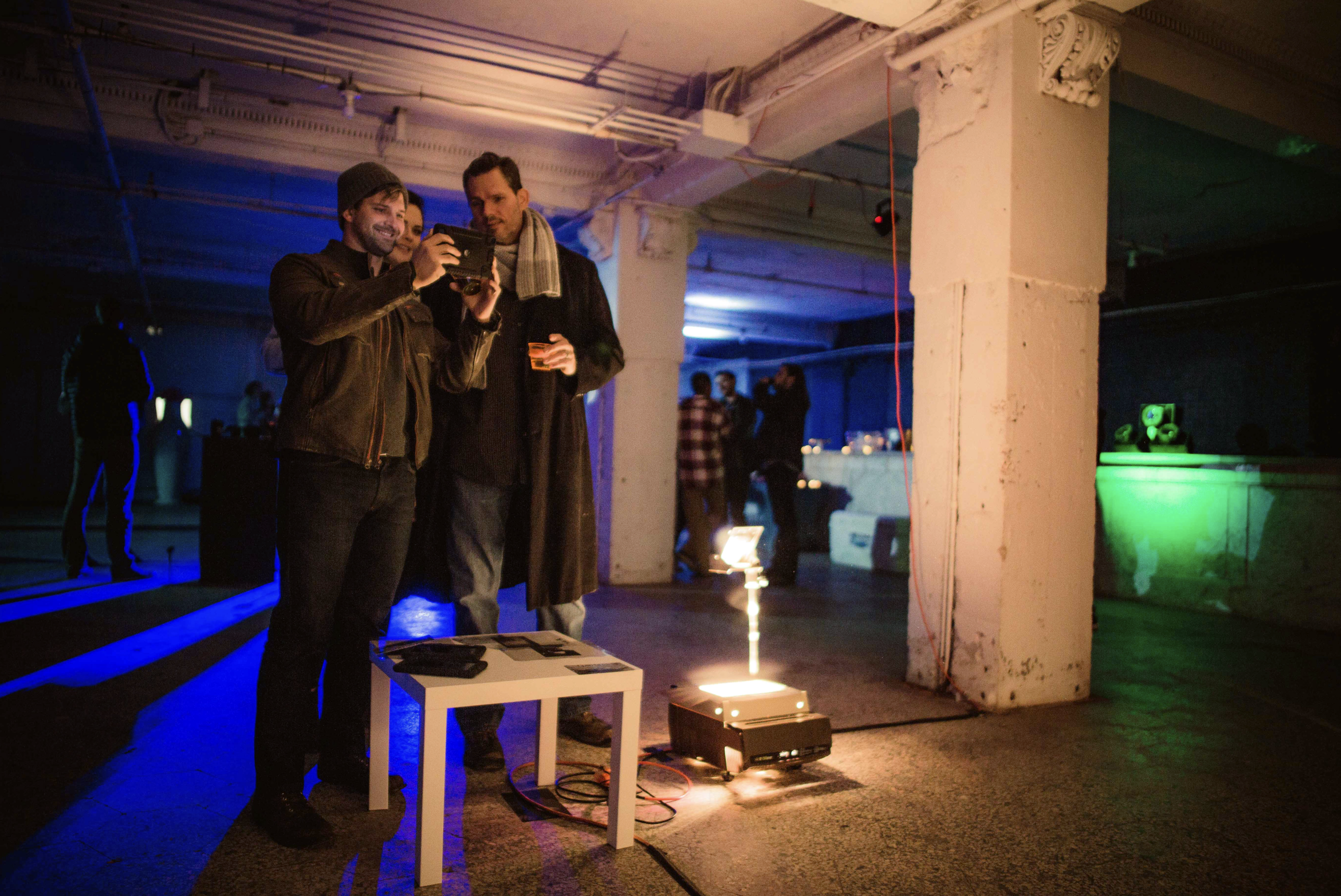Work samples
-
Renovations ExhibitA guided tour of select works of art. With RENOVATIONS, strikeWare Collective exhibits research on the Peale Center building, known historically as “Male and Female Colored School Number 1” to begin to look at the Black experience of education in Baltimore throughout history. In addition to a critical examination of historical and contemporary segregation in Baltimore City public schools, the show tracks the nine students who graduated from School Number 1 in 1889 - Baltimore’s first all-Black high school graduating class.
-
1st Nine Graduates ◦ Interactive Sculpture ◦ 2020Participants are invited to interact with this sculpture by dipping their fingers in chalk dust and gently rubbing the engraved text to expose it. This sculpture documents the lives of the 9 students who graduated from “Male and Female Colored School No. 1,” where they studied in the building now known as the Peale Center. In 1889, these students became the first African Americans to graduate public high school in Baltimore City. They went on to lead well-documented and often extraordinary lives, tracked here through articles in various newspapers, predominantly the Baltimore Afro-American.
-
ETA
ETA
Curated by Jordan Horton
Featuring Mollye Bendell, JLS Gangwisch, and Christopher Kojzar (strikeWare)ETA brings together new works by Mollye Bendell, JLS Gangwisch, and Christopher Kojzar—members of the Baltimore-based collective strikeWare—for an exhibition that explores the liminal spaces between movement and pause, certainty and disruption. Curated by Jordan Horton, the show draws on the familiar acronym “expected time of arrival,” using it as a metaphor for digital and physical states of transition: buffering screens, loading pages, interrupted journeys, and the unseen infrastructures that shape how we move through the world.
About strikeWare
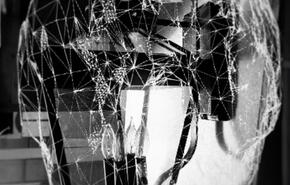
strikeWare is a Baltimore-based art collective formed to create action-oriented experiences using both traditional and new media. Our recent work aims to uplift and amplify stories critical to our American history, often using new technologies to emphasize the nowness of that history. strikeWare (Mollye Bendell, Jeffrey Gangwisch and Christopher Kojzar) ◦ collective focusing on interactive sculpture and immersive installations ◦ All… more
ETA
ETA: Rerouted is an exhibition of works by Mollye Bendell, JLS Gangwisch, and Christopher Kojzar, members of the Baltimore-based collective strikeWare who utilize multimedia to comment on the line between human and user experience. The exhibition explores abstract place and spatial relations, querying the concept of the journey versus the destination and all that one might encounter between the two. Bendell, Gangwisch, and Kojzar explore those “in-beween” spaces, both physically and digitally.
ETA is the popular acronym for “estimated time of arrival,” which is calculated based on the speed by which a vehicle has traveled over a specific distance. ETA can also describe, metaphorically, the time required to complete computational tasks like downloading or buffering. This metaphor plays out in the artists’ use of computer processing and virtual reality in their practices as well as in a wide array of transit-related happenings in Maryland, where the first iteration of this exhibition took place. The exhibition embodies the spirit of the universal experiences of movement, traveling, and rerouting. Like Rockville, Summit has a profile similar to that of a suburban town, located a stone’s throw away from a major city and understood by many as a place to pass through. Bendell, Gangwisch, and Kojzar, who live in different parts of the United States, add a compelling dimension to their exploration of transitory dwelling and the ways in which a collective continues to stay together despite its members being many miles apart. With place at the forefront of the artists’ inspiration, the works in the exhibition comment on liminality, the spaces through which people move, the politics of public space, and the varying state of transportation.
Bendell, Gangwisch, and Kojzar connect the physical to the virtual world through their use of mixed media, electronic technologies such as virtual reality and 3D rendering, and analog techniques and materials. While their practices use computational and digital material, each artist is indebted to traditional modes of art, as seen in their prints, drawings, and sculptures. Notes on the constant acceleration of technology are included in the exhibition’s various analog materials like cassette tapes, overhead projectors, and early models of televisions.
ETA: Rerouted invites viewers to consider shared space and all that occurs within it.
Unrested
In Unrested at the Julio Fine Arts Gallery, strikeWare invites the Baltimore community to examine the complex history of Jesuit slaveholding and its ongoing impact on Maryland communities, including those related to Loyola University. Unrested recognizes the 272 individuals sold by the Jesuits, reinterprets literature and visuals specific to Loyola University, and draws upon historical records to find parallels to current day trends. The exhibition will employ new media technologies, extended reality artworks, and interactive displays in an aestheticized exploration of the ongoing archival research pursued by students and faculty of Loyola University.
Unrested holds a mirror to an unresolved past. The exhibition overlaps material, message, and form to present how social institutions have affected several generations. We encourage the community to join us for this meaningful and thought-provoking exhibition: immersing themselves in the extended reality artworks, using devices to augment the material works displayed, or by being a part of the living sculptural installations.
-
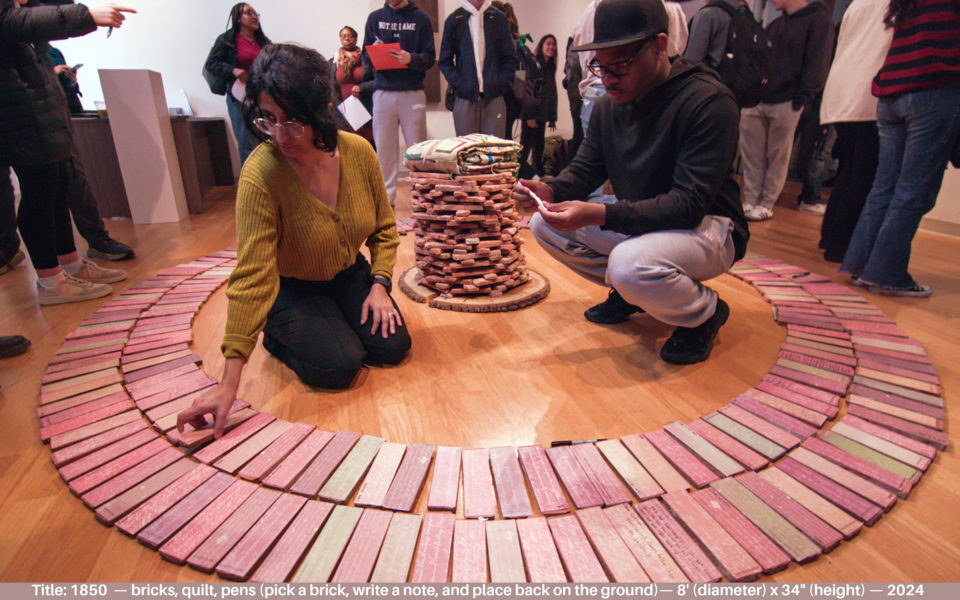 Unrested
UnrestedUnrested holds a mirror to an unresolved past. strikeWare's exhibition presents how social institutions like the church, school, and state have influenced several generations of black families. The artwork is titled by specific events, such as the year that the Jesuits sold 272 individuals to fund Loyola University, or 1889, which is a placard church pew dedicated to the year that the first all-black class graduated from Baltimore's public school system.
1850— bricks, quilt, pens (pick a brick, write a note, and place back on the ground)— 8' (diameter) x 34" (height) — 2024
-
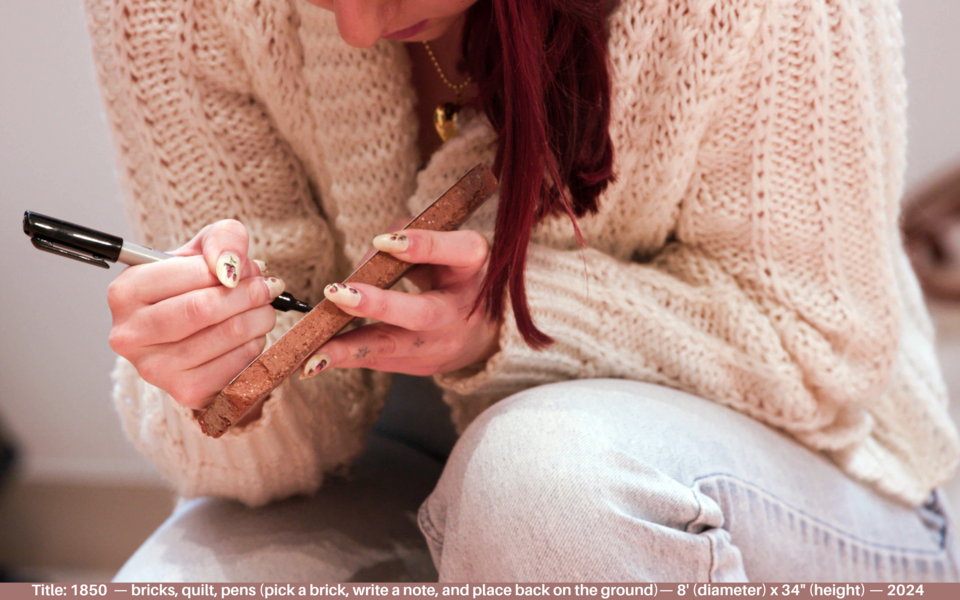 1850
18501850 | 2024 | 272 bricks, pens, and quilt
Pick a brick, write a note, and place back on the ground.
-
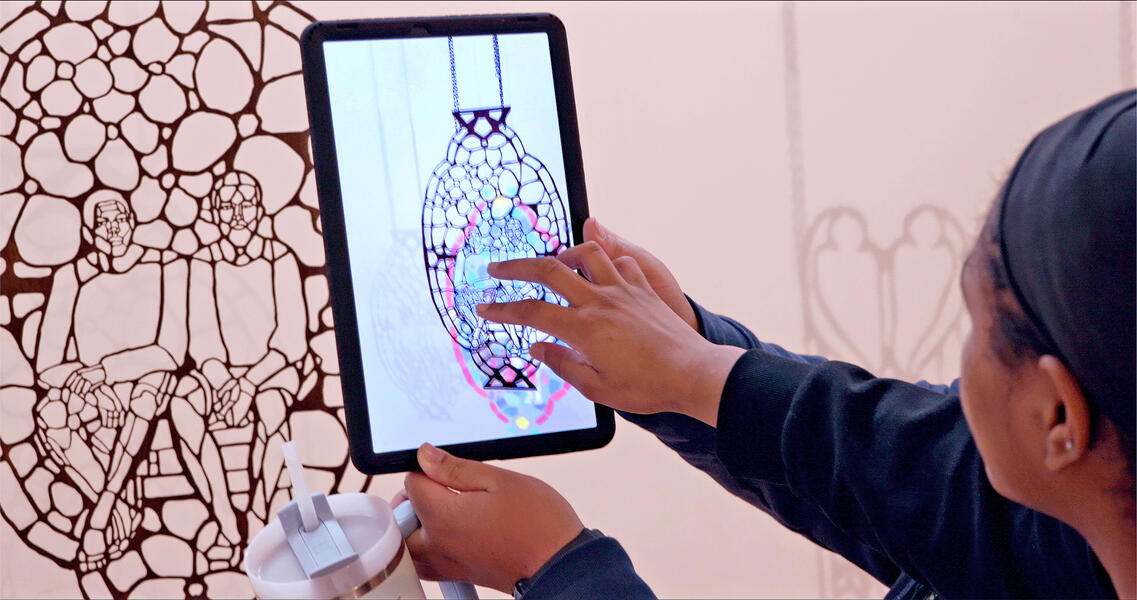 1954, 1969, 1971
1954, 1969, 19711954, 1969, 1971 | 2024 | frames with AR component, tablet
Use the tablet to make sunbeams in augmented reality.
-
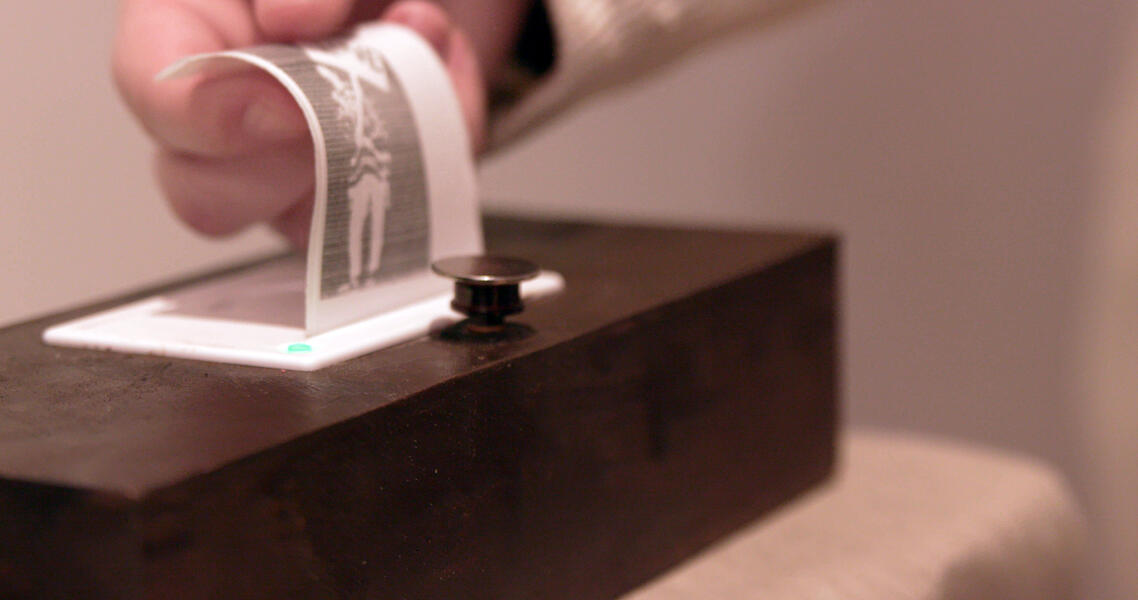 2024
20242024 | 2024 | sticker printer
Takeaway art generator. Press the red button.
-
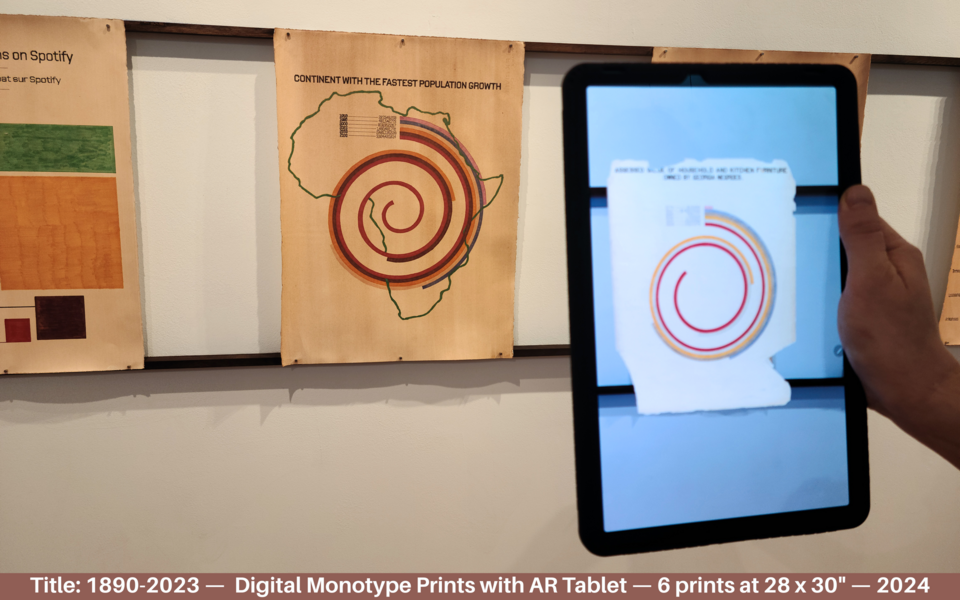 1890
18901890 | 2024 | graphs with AR Component
Use the tablet to reveal 1890 WEB Dubois infographics in augmented reality.
-
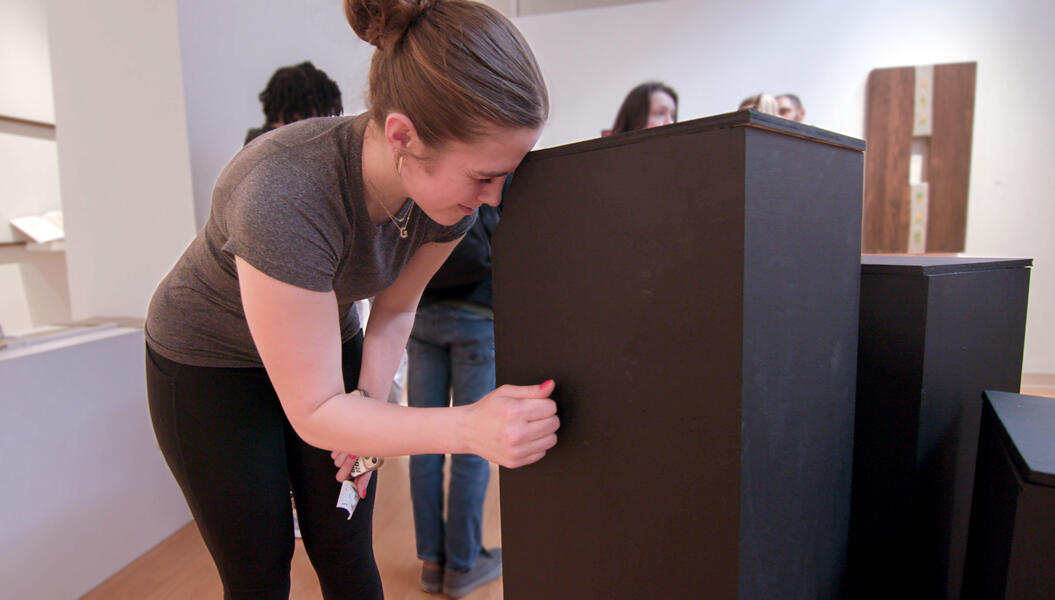 11_Unrested.jpg
11_Unrested.jpg1906 | 2024 | black box with a reflective pool
Look into the boxes and knock gently on the sides
-
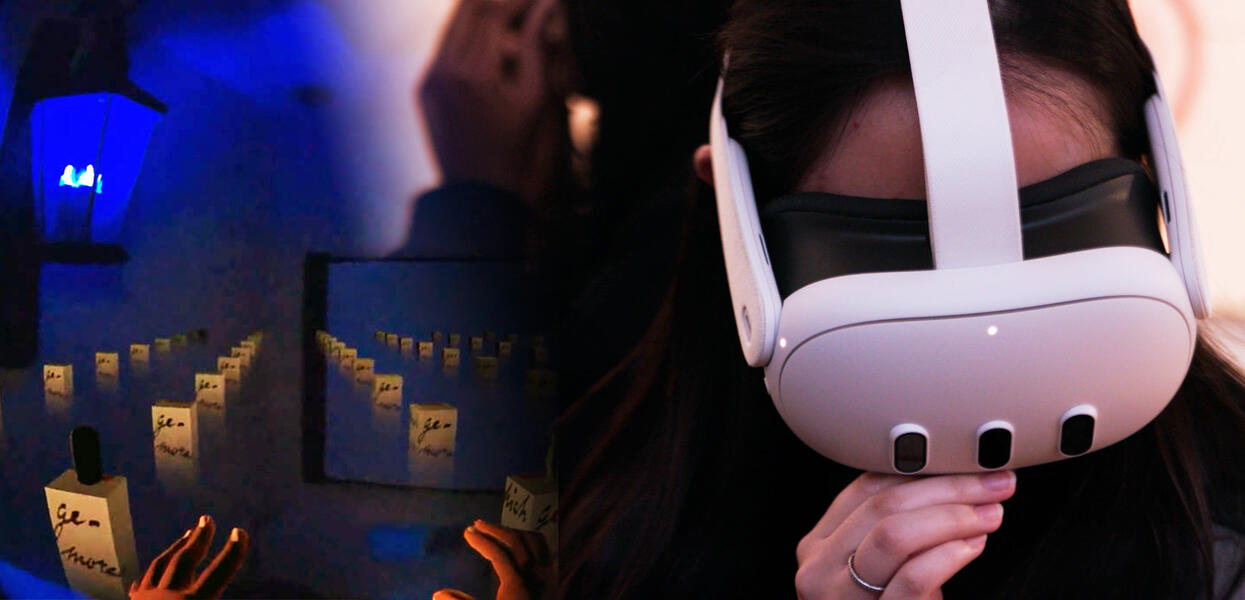 1922
19221922 | 2024 | Virtual Reality Passthrough
-
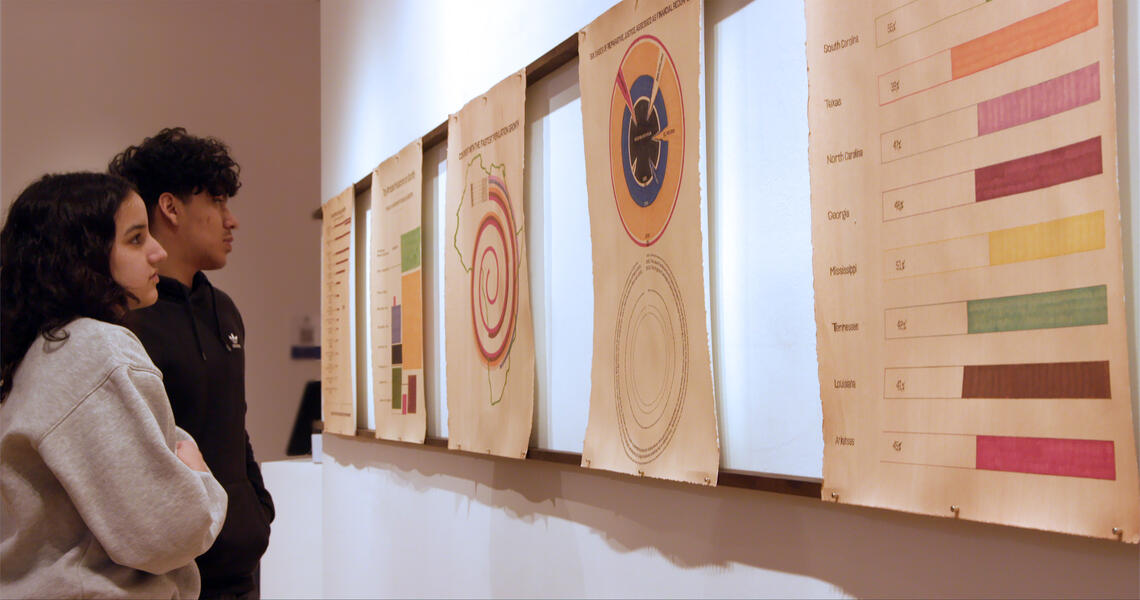 1890
18901890 | 2024 | graphs with AR Component
Use the tablet to reveal 1890 WEB Dubois infographics in augmented reality.
-
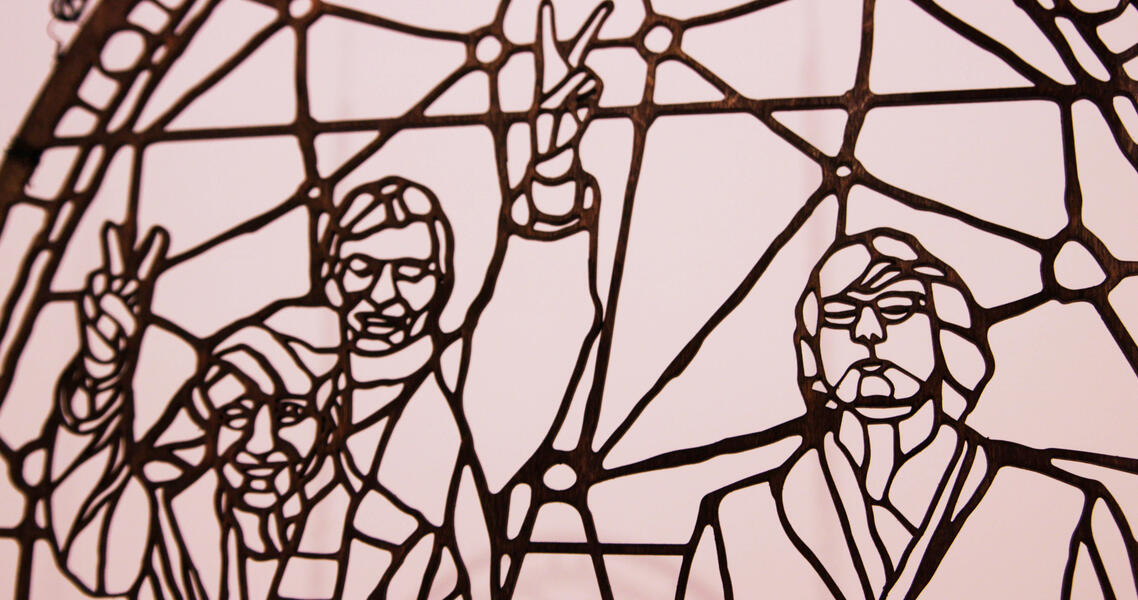 03_Unrested_1.jpg
03_Unrested_1.jpg1954, 1969, 1971 | 2024 | frames with AR component, tablet
Use the tablet to make sunbeams in augmented reality.
-
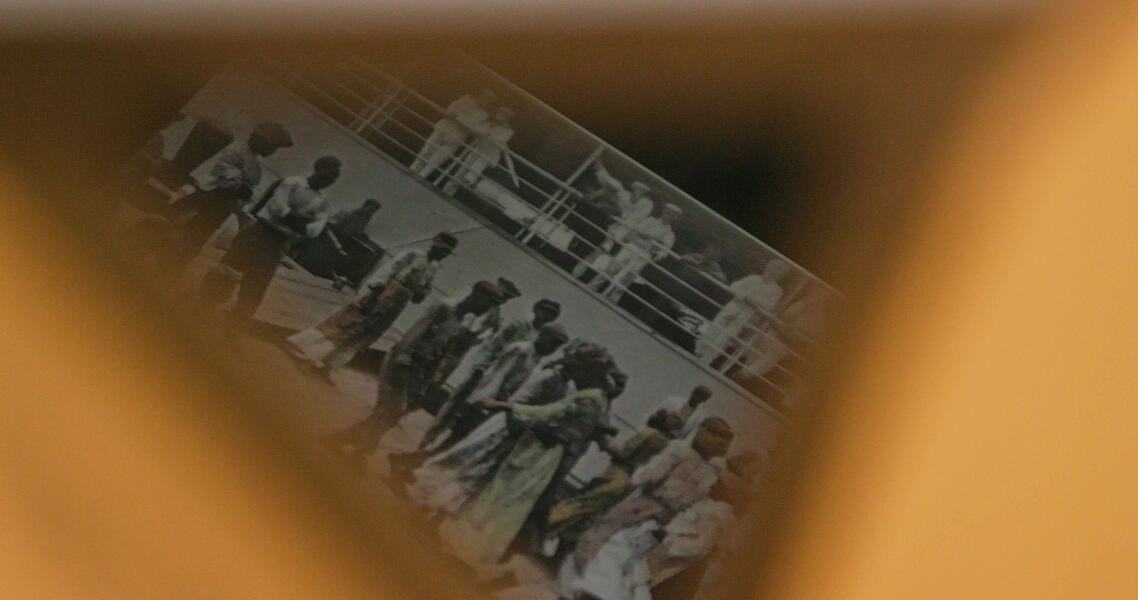 1906
19061906 | 2024 | black box with a reflective pool
Look into the boxes and knock gently on the sides
Next Generations: Turning the Page
For the Jewish Museum of Maryland’s reopening exhibition, Next Generations: Turning the Page, strikeWare was invited to respond to Generations—the museum’s long-running publication (1978–2012) that gathered stories from more than 180 writers and became a vital record of Maryland’s Jewish history and culture. As the Museum reactivates this archive through contemporary interpretations, our contribution positions these texts as springboards for re-mapping Baltimore’s layered geographies of migration, memory, and belonging.
Guided by the five articles selected by the Generations advisory committee, strikeWare (@jgangwisch @moss.piglet @christopher_ko) developed five sculptural works and an accompanying augmented reality experience. These pieces imagine the movements, testaments, and spatial imprints of Jewish communities across Baltimore, and consider how these trajectories intersect with the city’s histories of racial segregation, displacement, and neighborhood transformation.
Our research constellation included the Arch Social Club, the downtown eruv, Sanborn Fire Insurance Maps, and Antero Pietila’s Not in My Neighborhood, each placed in dialogue with the narratives preserved in Generations. We were particularly compelled by the ways Jewish migration both mirrored and diverged from Black experiences of containment and mobility throughout the 19th and 20th centuries.
-
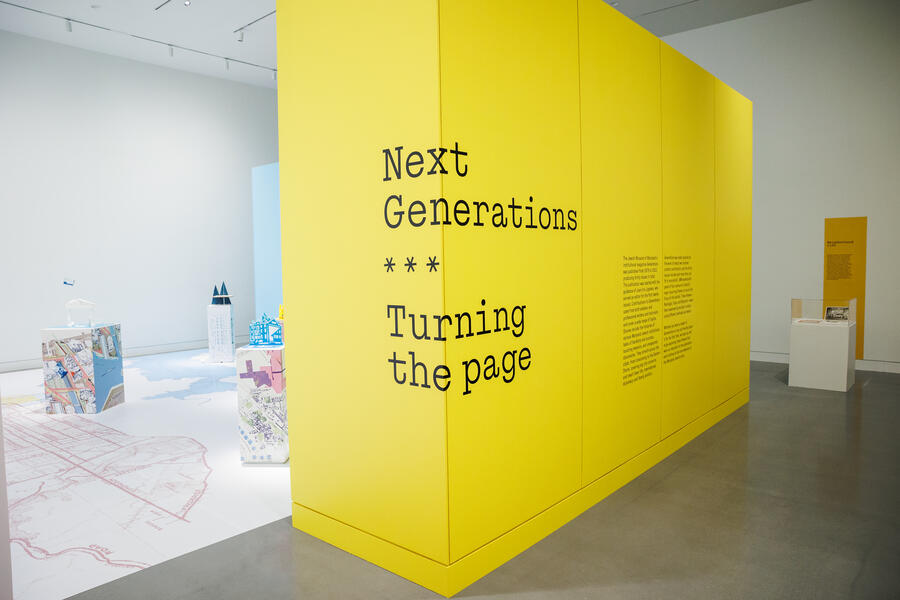 Next Generations: Turning the Page
Next Generations: Turning the PageVisitors are met by "Next Generations: Turning the Page" and a landscape of augmented reality activated maps that spill from the wall onto the floor into a series of sculptural pedestals. Each pedestal carries a hand-drawn cartography adapted from the Sanborn public archive, while a room-scale map unfurls beneath your feet, studded with references pulled from the Museum’s collections. Together, these layers—wall text, mapped surfaces, and standing forms—create a spatialized memory terrain where archival histories, neighborhood boundaries, and lived experience collide.
Through this multi-layered approach—physical, archival, and augmented—strikeWare traces how communities continually shape and reshape the places they inhabit, and how these stories echo across Baltimore’s neighborhoods long after a page is turned.
-
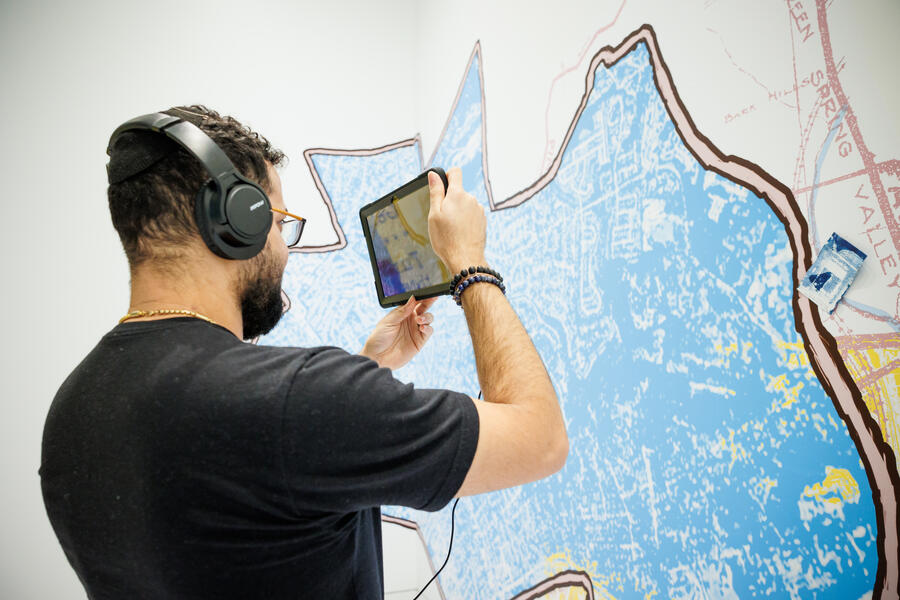 The AR app
The AR appA person wearing headphones holds up a tablet to view an augmented reality layer over a large, room-scale map of Baltimore displayed on the wall. The AR app reveals additional information connected to the museum’s oral histories, activating audio within the exhibition with digital overlays and interactive content. The installation draws on historical Baltimore Sanborn fire insurance maps—detailed atlases first produced in the late 19th and early 20th centuries to document building materials, property boundaries, and neighborhood infrastructure. Created originally to assess urban fire risk, these maps served as an interface for the city’s shifting geography, migration patterns, and zoning practices.
-
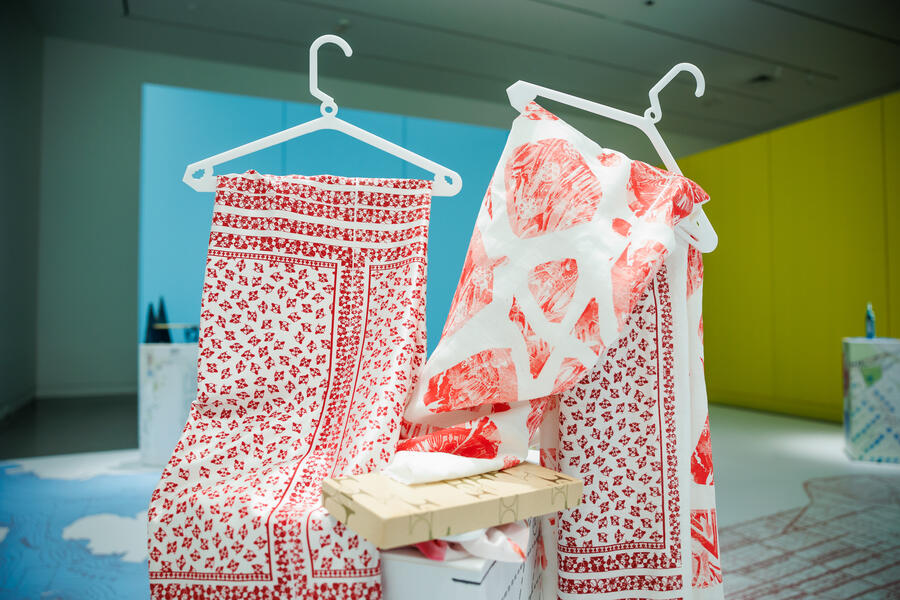 unclaimed
unclaimedTwo patterned scarves hang from white acrylic hangers, each printed with silkscreened emblems and pin-inspired motifs. Rendered in red on white fabric, the designs draw from objects such as the papercuts, a Jews of Color pin, a gold Acorn pin, and other archival references. Draped over a pedestal, the textiles echo the visual language of memorabilia and garment history, connecting personal adornment to Baltimore’s broader histories of labor and identity. Silkscreen on fabric with white acrylic hangers — 3' × 28" × 20" — 2025.
Links to referenced artwork and memorabilia:
https://jewishmuseummd.catalogaccess.com/photos/68731
https://jewishmuseummd.catalogaccess.com/objects/12214
https://jewishmuseummd.catalogaccess.com/objects/11942
https://jewishmuseummd.catalogaccess.com/objects/4048
Available for Purchase -
 Swimmers in Druid Hill
Swimmers in Druid HillThis sculpture layers three archival sources from Generations into a single spatial narrative about segregation, leisure, and exclusion in Baltimore’s recreational spaces. The wire cut-out supporting the platform is drawn directly from a 1948 newspaper photograph showing a white man being carried away by two police officers during a confrontation at Druid Hill Park’s segregated recreational facilities. The original image—printed in the Baltimore Afro-American and reproduced in the 2004 Generations issue—captures the physical enforcement of racial division in public leisure spaces.
Above this, the green triangular forms are constructed from the Suburban Club’s dining menu (p. 11), a symbol of the social exclusivity of Baltimore’s Jewish country clubs. In Generations, menus and club documents illustrate how access to suburban leisure—pools, tennis courts, dining rooms—was shaped by class, ethnicity, and institutional boundaries. These menu-turned-“trees” reference the carefully curated landscapes of private clubs, contrasting sharply with the contested terrain of public parks.
Beneath the sculpture, the pool floor is printed with an image of Black swimmers in the Druid Hill Park pool (p. 45), one of the few facilities available to African Americans under Baltimore’s “separate but equal” system. The photograph in Generations highlights how the park became a site of racial tension, resistance, and eventual integration.
Together, these elements compress a century of Baltimore’s recreation history into a single object: the private country-club ideal floating above the realities of racial policing, while the public pool below holds the memory of Black Baltimoreans whose access to leisure was regulated, contested, and eventually transformed. The sculpture becomes a material conversation between privilege and restriction, aspiration and exclusion, and the layered histories of who gets to rest, play, and belong.
-
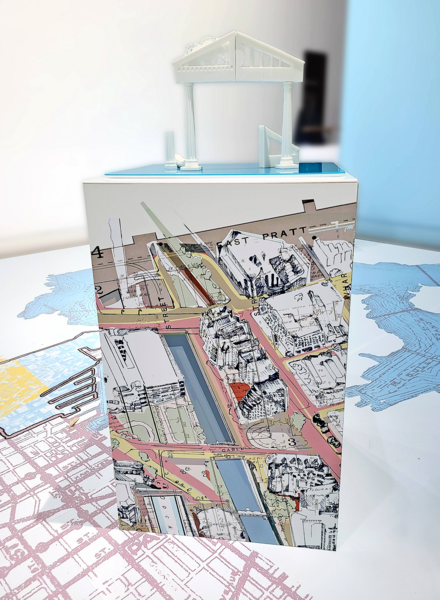 Those pediment and portico footprints
Those pediment and portico footprints3D print over vinyl-wrapped Pedestal — 44" x 28" x 28" — 2025
-
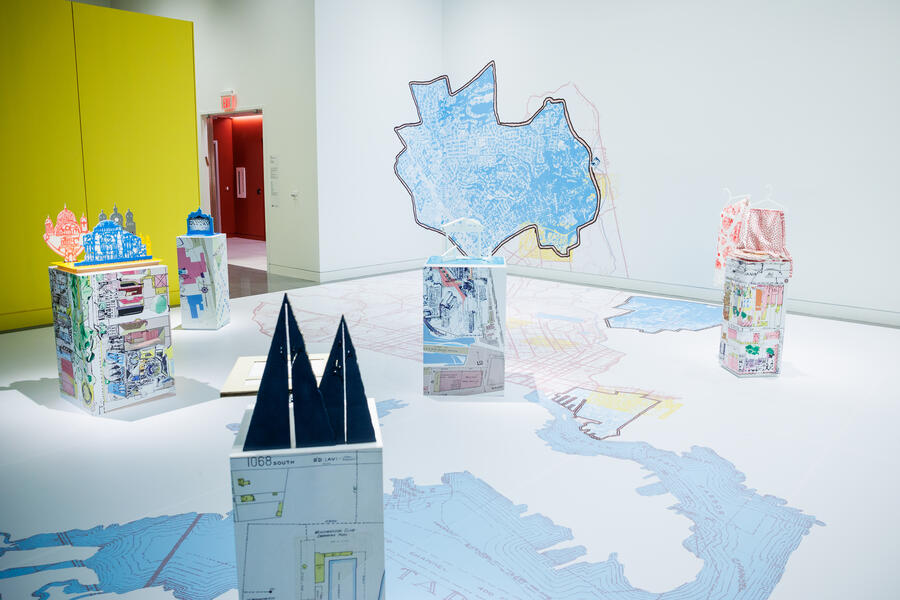 Next Generations: Turning the Page
Next Generations: Turning the PageNext Generations: Turning the Page — Migration section — Jewish Museum of Maryland — 2025
-
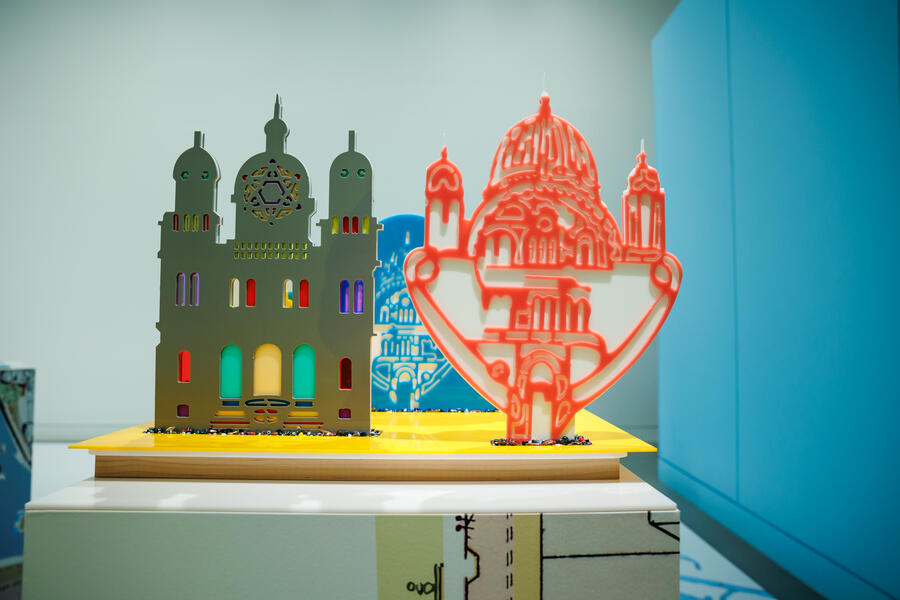 What architecture's at Hagia Sofia, was remembered in Florence, at the doors of Eutaw Place Temple
What architecture's at Hagia Sofia, was remembered in Florence, at the doors of Eutaw Place TempleAcrylic cut-outs over vinyl-wrapped Pedestal — 50" x 28" x 28" — 2025
Sculptures at times refer to buildings that Baltimore’s Black community claim after mid-20th century white flight.
-
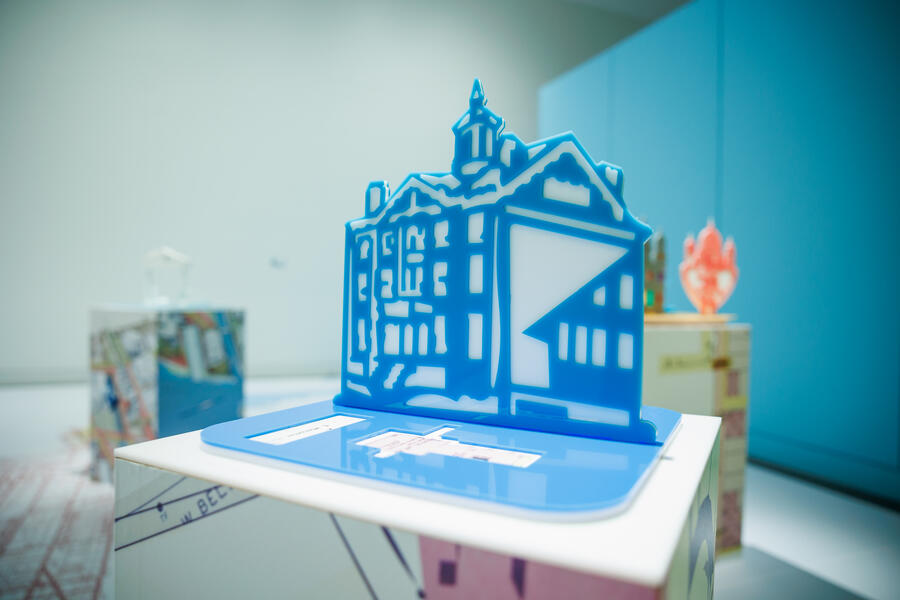 mt sinai hospital
mt sinai hospitalA bright blue acrylic silhouette of a historic building rises from a pedestal layered with maps and archival fragments. The form functions as a memory-marker of Baltimore's first Jewish hospital.
Mt. Sinai Hospital in New York wasa established in 1852 by German Jewish immigrants. At that time, Jewish doctors were routinely denied positions in mainstream hospitals, and Jewish patients often faced unequal or discriminatory treatment. In response, the community came together to build its own hospital—first known as the Jews’ Hospital in the City of New York—so that their physicians could practice and advance, and their patients could receive care grounded in dignity, cultural understanding, and religious accommodation.
Over time, Mt. Sinai grew into a regional, widely recognized medical institution.
-
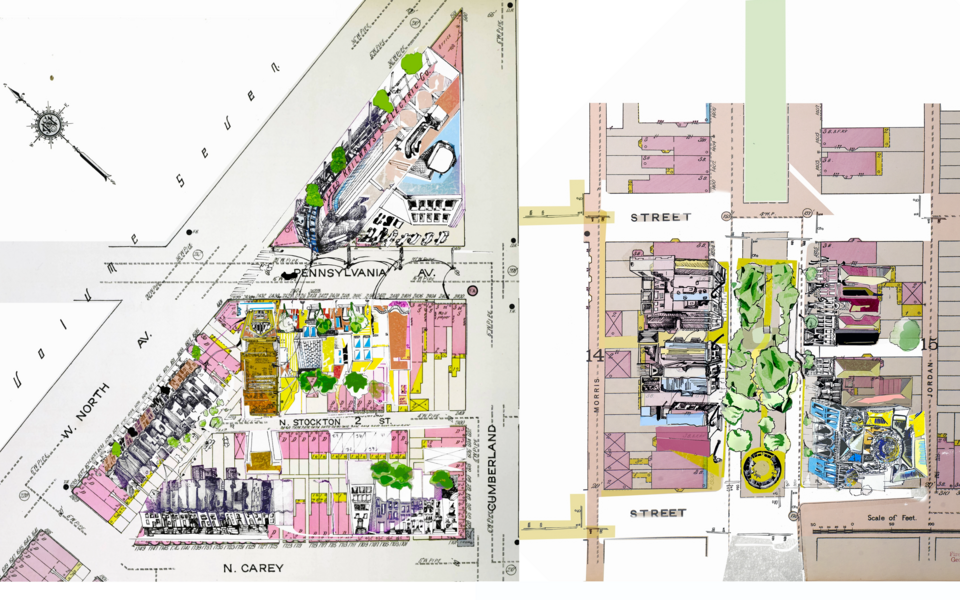 maps of Arch Social Club (Schanze Theater) and Black Masonic Organization- MWPHGLMD (Eutaw Place Synagogue)
maps of Arch Social Club (Schanze Theater) and Black Masonic Organization- MWPHGLMD (Eutaw Place Synagogue)pen and digital drawing over Sanborn map —size variable — 2025
Sanborn maps are redigitized with pen drawing to highlight Baltimore changing landscape. Antero Pietila's 'Not in my Neighborhood' and Dara Horn’s “People Love Dead Jews” are just a couple nodes of research that were paired along with the Jewish Museum of Maryland’s “Generations” publication and their decades-long collection of artifacts.
-
 Next Generations: Turning the Page
Next Generations: Turning the PageVisitors of multiple generations stand within an immersive installation where the floor is transformed into a large-scale map—its lines and color fields evoking histories embedded in urban space. This installation is part of the Jewish Museum of Maryland’s exhibition: Next Generations – Turning the Page, which explores how history is transmitted, questioned, and reimagined across generations. The exhibition invites participants to consider how stories—especially those tied to displacement, migration, labor, and cultural identity—are carried forward, reshaped, and expanded through new technologies, collaborative artmaking, and intergenerational dialogue.
Educational Values
This body of work weaves traditional and new media to present a visual experience about the institutions, educators and progenitors who shaped how Baltimore’s Black community acquired formal training and knowledge. In addition to a critical examination of historical and contemporary segregation in Baltimore City public schools, strikeWare tracks the nine students who graduated from School Number 1 in 1889 - Baltimore’s first all-Black high school graduating class. Visit WYPR here to listen to an interview with Sheilah Kast.
-
RENOVATIONS - a walk through tourRenovations examines the history of African-American education in Baltimore from the founding of the city's first public high school for Black students to the present day. The show was open at the Carroll Mansion and from January 10th-March 1st 2020 (with a gallery talk on February 8th). Renovations uses media such as virtual and augmented reality, interactive sculpture and immersive projection to draw out the hidden narratives and ongoing struggles in our educational system.
-
The First Nine GraduatesParticipants are invited to interact with this sculpture by dipping their fingers in chalk dust and gently rubbing the engraved text to expose it. This sculpture documents the lives of the 9 students who graduated from “Male and Female Colored School No. 1,” where they studied in the building now known as the Peale Center. In 1889, these students became the first African Americans to graduate public high school in Baltimore City. They went on to lead well-documented and often extraordinary lives, tracked here through articles in various newspapers, predominantly the Baltimore Afro-American.
-
85° 60°Many Baltimore City Public Schools still lack adequate HVAC. If the internal temperature of their school registers above 85 degrees or below 60 degrees, students will be dismissed for the day ◦ Actual Dimensions (w-h-d) : 90" x 50" x 30"
-
1000 strikeMarks1000 strikeMarks contextualizes the space in which the Renovations exhibit took place, the Carroll Mansion. The sculpture’s images are sourced from found lithographs. The AR app reveals a history published by Christopher Phillips in his book “Freedom's Port: The African American Community of Baltimore, 1790-1860” ◦ wood sculpture | LED Light | Augmented Reality | Digital Print | 86 x 100 x 18 (h x w x d)
-
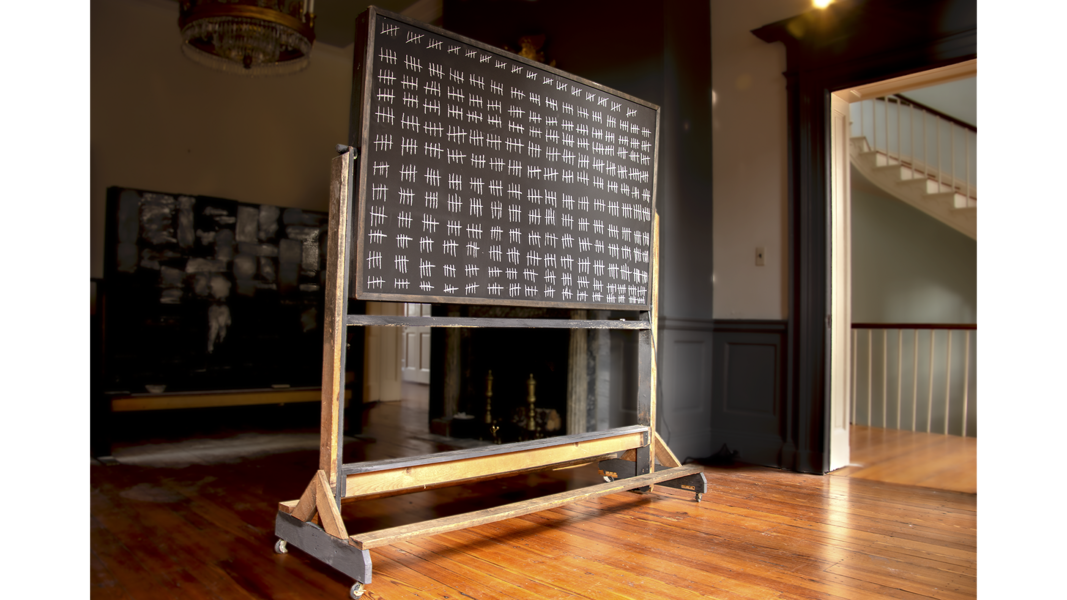 1000 strikeMarksalternate view
1000 strikeMarksalternate view -
Hosanna School at 360°The Berkley School was built by five black men acting as Trustees in 1868 largely because efforts of the Freedmens' Bureau proved ineffective in this part of Maryland and stands as a rare, early instance of black-begun and black-run educational efforts in the former slave-owning areas of the nation. The second story was for the just-established Hosanna Church and was also used for meetings by various black fraternal orders and lodges."
-
Bethel AME (The Written History)Audiobook | 2019-2020 | Narrated by strikeWare Collective member Christopher Kojzar. "Selected African American Educational Efforts in Baltimore, Maryland during the Nineteenth Century by Brian Courtney Morrison, PhD. (published in December 2008)
-
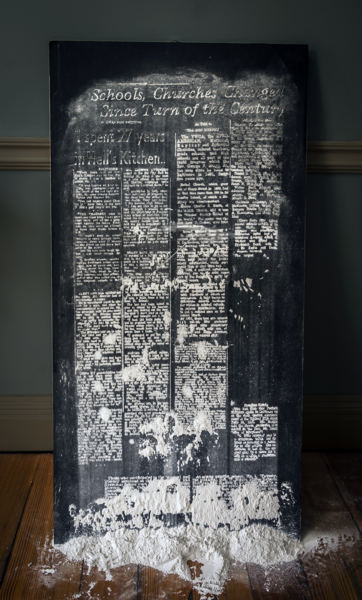 Schools, Churches Changed Since Turn of the Century ◦ 2019This slab is engraved with Baltimore Sun and AFRO newspaper articles, Mamie Neale's diploma (engraved calligraphy), and a nostalgia piece by H. Grafton Browne, a high school principal from the time period. The chalkdust exposes these article snippets and outlines the connection between schools and church life in the late 19th & early 20th century ◦ wood | paint | chalk | (h-w-d): 49” x 29” x 3"
Schools, Churches Changed Since Turn of the Century ◦ 2019This slab is engraved with Baltimore Sun and AFRO newspaper articles, Mamie Neale's diploma (engraved calligraphy), and a nostalgia piece by H. Grafton Browne, a high school principal from the time period. The chalkdust exposes these article snippets and outlines the connection between schools and church life in the late 19th & early 20th century ◦ wood | paint | chalk | (h-w-d): 49” x 29” x 3" -
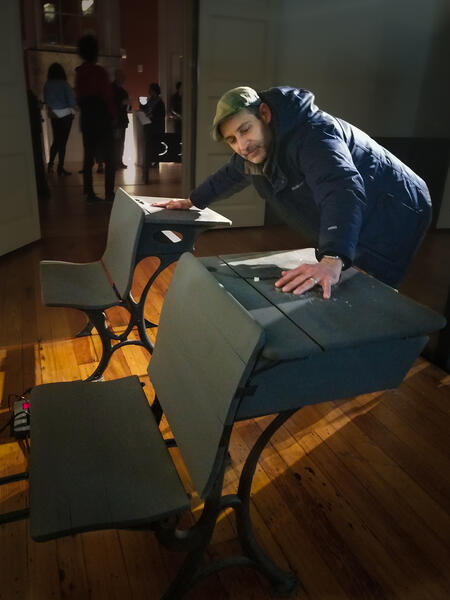 85° 60° ◦ 2020The desk on the left is cooled to 60 degrees. The desk on the right is warmed to 85 degrees. Actual Dimensions (w-h-d) : 90" x 50" x 30"
85° 60° ◦ 2020The desk on the left is cooled to 60 degrees. The desk on the right is warmed to 85 degrees. Actual Dimensions (w-h-d) : 90" x 50" x 30" -
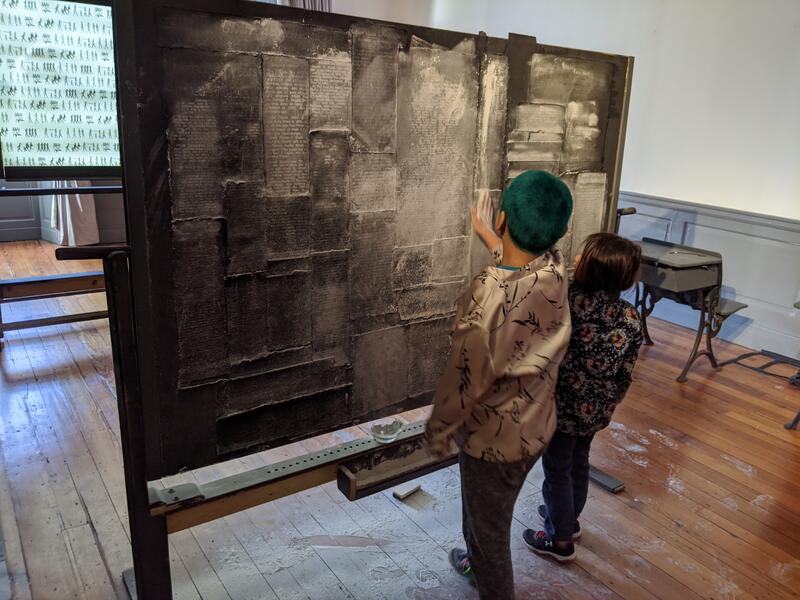 The First Nine Graduates ◦ 20203D wood sculpture | laser-etched paper | chalk dust | Actual Dimensions (w-h-d) : 88" x 65" x 12"
The First Nine Graduates ◦ 20203D wood sculpture | laser-etched paper | chalk dust | Actual Dimensions (w-h-d) : 88" x 65" x 12"
The Peale Center
This link directs the browser to research conducted by Dean Krimmel, Mary Ellen Hayward, and The Contemporary.
Tonika D. Berkley, Research Coordinator and Curator for the Peale Center played a vital role in guiding the development of the original RENOVATIONS exhibit
-
Blueprints ◦ 2020The strikeWare app reveals an augmented reality view of the Peale Center. The school was ultimately shut down due to poor working conditions and overcrowding. The figures presented in the augmented reality application come from an 1885 editorial in the Baltimore Sun expressing concern about those conditions.
-
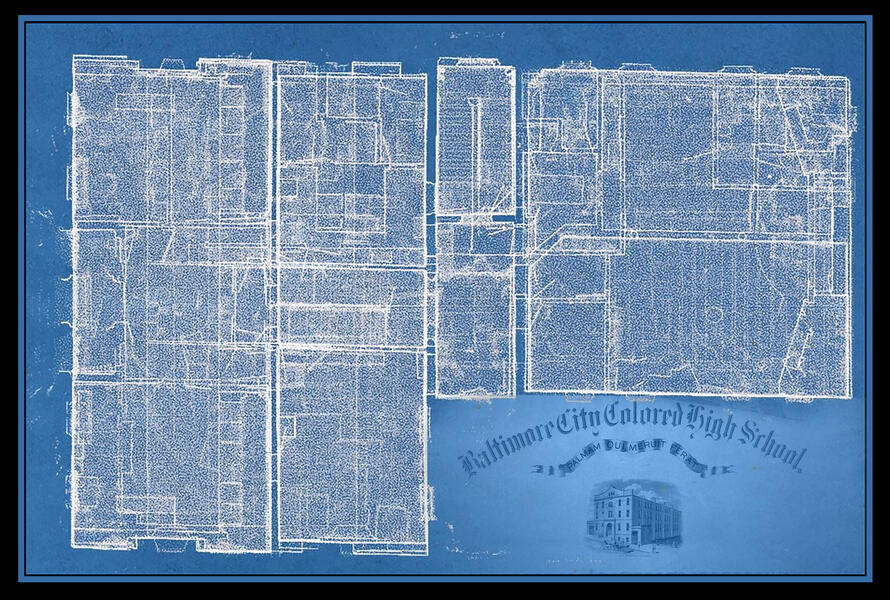 Blueprints ◦ 2020Dr. G.L. Staley, principal, and Mr. Plaskitt of the school board and others “earnestly insist that the colored high and grammar school, male and female, “totally unfitted to accommodate so many pupils as are crowded into it, and therefore is unhealthy and even dangerous.” The first floor has three rooms of moderate size that seat 140 pupils—40 more than are comfortable. The second floor has five rooms, two very small, for 235 pupils. The third floor has four rooms and 200 pupils. Three of them ought not to have more than 35 pupils in each. The principal has taken the second section of the grammar school into his room. The stairways from the second to the third floor are only three feet wide. February 18, 1885 The Baltimore Sun
Blueprints ◦ 2020Dr. G.L. Staley, principal, and Mr. Plaskitt of the school board and others “earnestly insist that the colored high and grammar school, male and female, “totally unfitted to accommodate so many pupils as are crowded into it, and therefore is unhealthy and even dangerous.” The first floor has three rooms of moderate size that seat 140 pupils—40 more than are comfortable. The second floor has five rooms, two very small, for 235 pupils. The third floor has four rooms and 200 pupils. Three of them ought not to have more than 35 pupils in each. The principal has taken the second section of the grammar school into his room. The stairways from the second to the third floor are only three feet wide. February 18, 1885 The Baltimore Sun -
Through the Tempest to the StarsThrough the Tempest to the Stars ◦3 Channel Immersive, Interaction Installation ◦ Pick up the black block to control this interactive installation inspired by the ceremony of the first graduates of the Colored High School. This work features contributions from the Peale Center, the Hosanna School, and Direct Dimensions. The title is the motto of the 1889 graduating class.
-
Through the Tempest to the Stars (Primary View)What you see here is a screen recording of one of the three video channels as an unseen user interacts with the piece. In its first exhibition, a user would pick up a black box and use it to navigate the environment. This work features contributions from the Peale Center, the Hosanna School, and Direct Dimensions. The title is the motto of the 1889 graduating class.
-
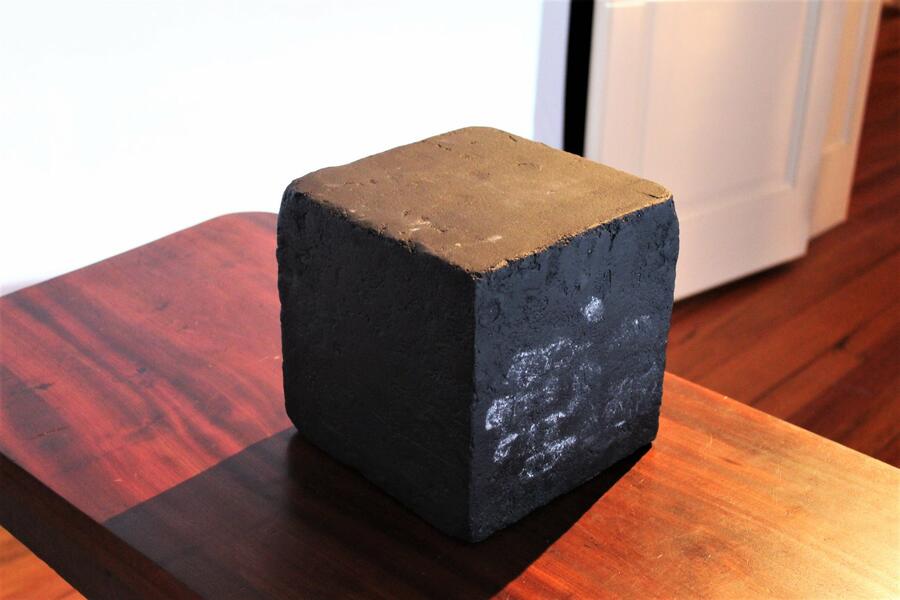 Controller for Tempest ◦ 2020This chalked block allows the particpant to control the movements of the three screen projection ◦ Actual Dimensions: 10" cube
Controller for Tempest ◦ 2020This chalked block allows the particpant to control the movements of the three screen projection ◦ Actual Dimensions: 10" cube -
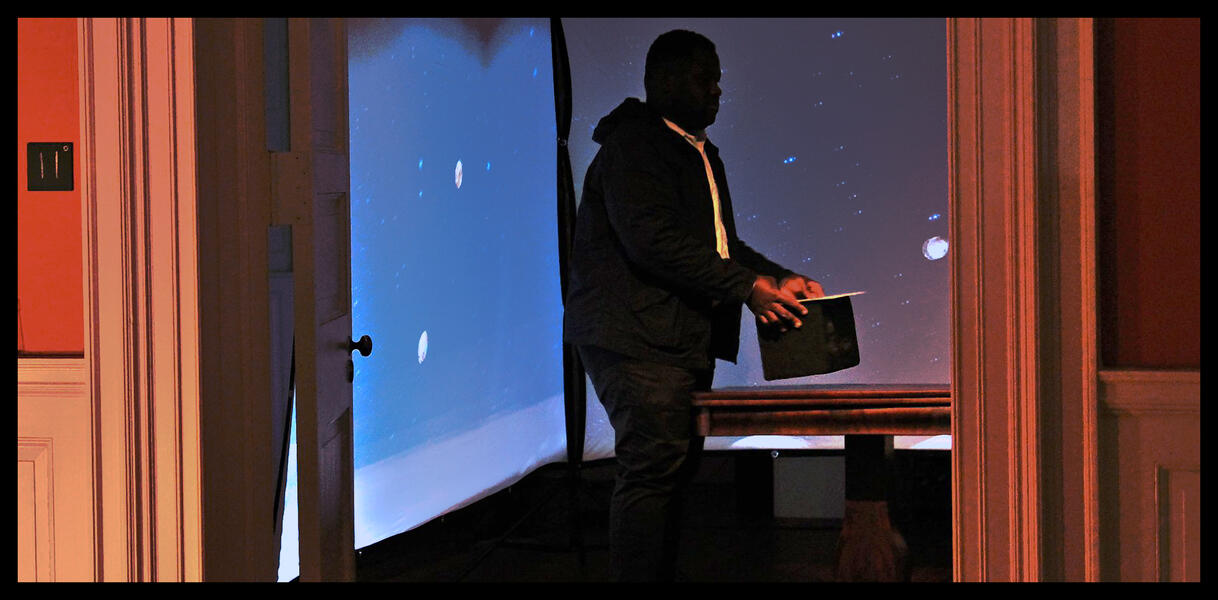 Through the Tempest to the Stars ◦ 2020A participant plays "Through the Tempest to the Stars"
Through the Tempest to the Stars ◦ 2020A participant plays "Through the Tempest to the Stars" -
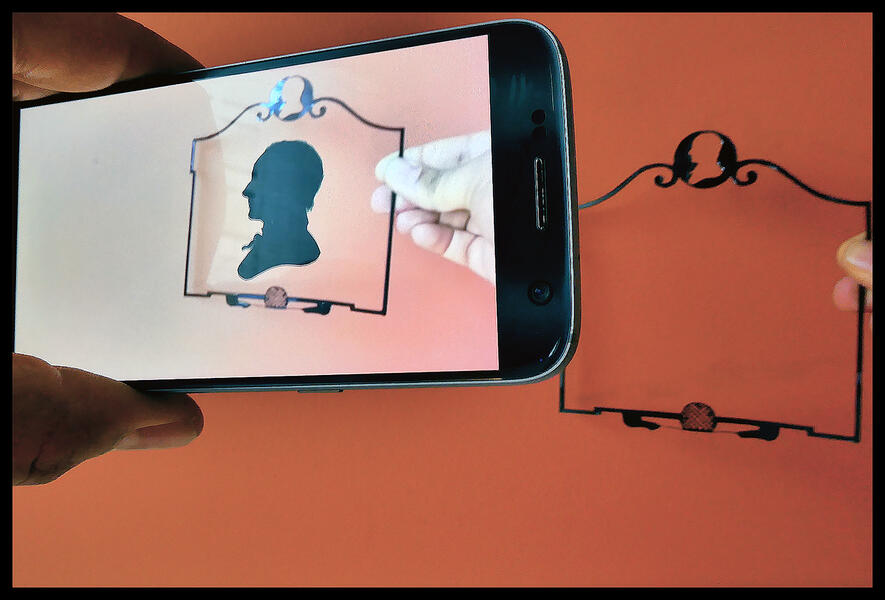 a likeness of Charles Willson Peale ◦ 2020The AR app reveals a portrait cut by Moses Williams. WIlliams was born into slavery and grew up in the household of the artist Charles Willson Peale. While Peale’s sons studied painting, Williams had only the physiognotrace, a silhouette-making machine used to trace a reduced outline of the sitter.
a likeness of Charles Willson Peale ◦ 2020The AR app reveals a portrait cut by Moses Williams. WIlliams was born into slavery and grew up in the household of the artist Charles Willson Peale. While Peale’s sons studied painting, Williams had only the physiognotrace, a silhouette-making machine used to trace a reduced outline of the sitter. -
a likeness of Charles Willson Peale (video document)Augmented Reality | Digital Art Sculpture | This acrylic cut-out reimagines an historical signpost to reveal a hidden silhouette about our shared history. The historical signposts are displayed by various state historical societies along roadways throughout the United States. Further reading: "Moses Williams, Cutter of Profiles: Silhouettes and African American Identity in the Early Republic" by Gwendolyn DuBois Shaw.
-
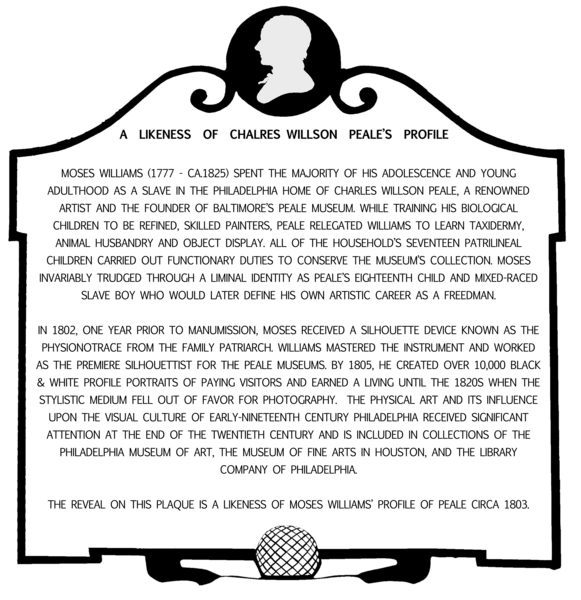 Moses Williams Plaque ◦ 2020The design for this template mimics the signposts displayed by various historical societies along roadways throughout the United States. The narratives tend to promote a washed over past that deflects any notion of the struggle that Blacks and Indigenous people confronted in the face of colonization.
Moses Williams Plaque ◦ 2020The design for this template mimics the signposts displayed by various historical societies along roadways throughout the United States. The narratives tend to promote a washed over past that deflects any notion of the struggle that Blacks and Indigenous people confronted in the face of colonization. -
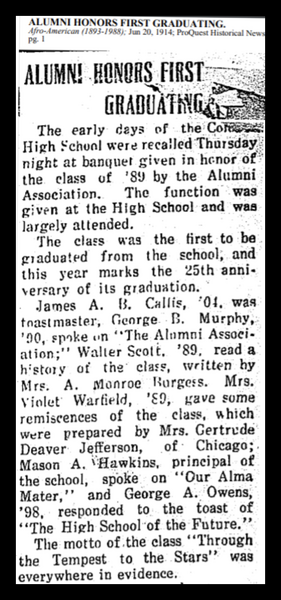 "Thru the Tempest" ◦ 1889 article
"Thru the Tempest" ◦ 1889 article
fishTank
-
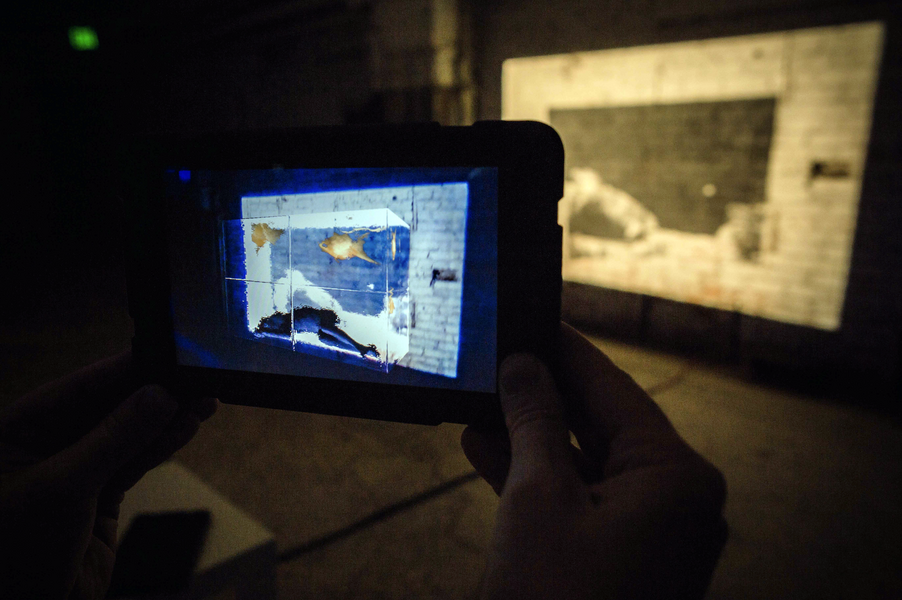 fishTank_sea ◦ 2018Augmented-reality installation ◦ When viewed through the accompanying mobile application, the viewer may see a three-dimensional virtual sculpture showing ornamental fish swimming with 3D photographs of human figures within an enclosed space.
fishTank_sea ◦ 2018Augmented-reality installation ◦ When viewed through the accompanying mobile application, the viewer may see a three-dimensional virtual sculpture showing ornamental fish swimming with 3D photographs of human figures within an enclosed space. -
 fishTank_sea ◦ 2018An overhead transparency projector rests on the floor with four interchangeable images of artificial aquatic interiors.
fishTank_sea ◦ 2018An overhead transparency projector rests on the floor with four interchangeable images of artificial aquatic interiors. -
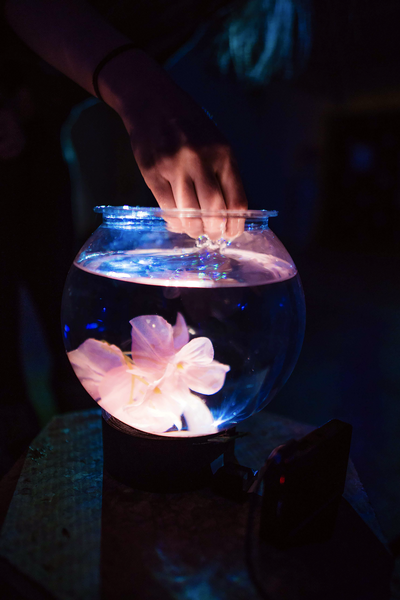 fishTank_flower ◦ 2018Digital Video Installation A water source slowly drips water into a fishbowl with a bright pink flower. A video feed from underneath the fishbowl is projection mapped onto six of the Marble Bar's support columns.
fishTank_flower ◦ 2018Digital Video Installation A water source slowly drips water into a fishbowl with a bright pink flower. A video feed from underneath the fishbowl is projection mapped onto six of the Marble Bar's support columns. -
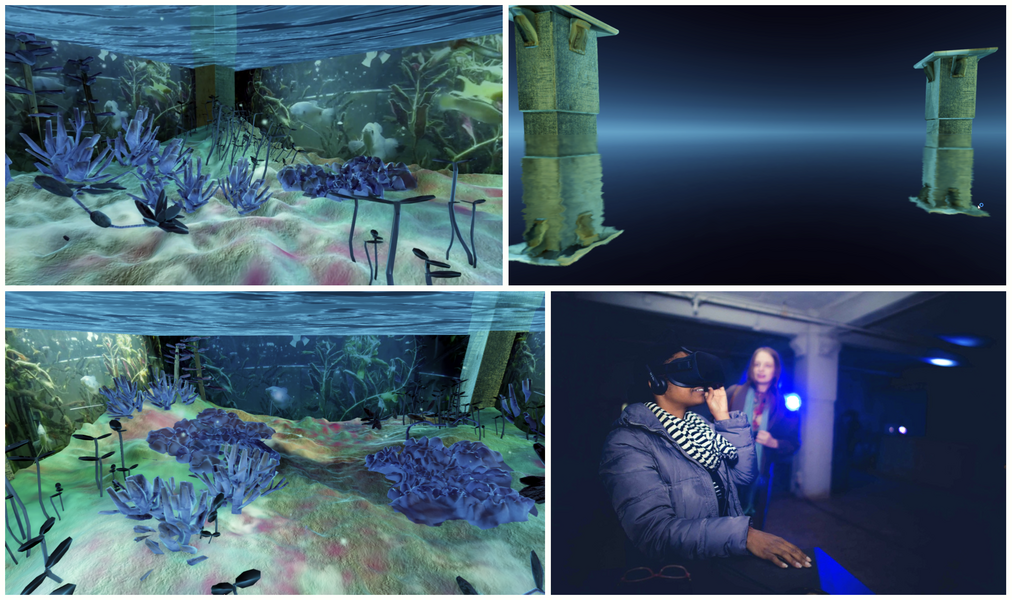 fishTank_A Coral Reef ◦ 2018Coral Reef transports the interactor into a future in which the building had been underwater for centuries, leaving only the pillars of the basement.
fishTank_A Coral Reef ◦ 2018Coral Reef transports the interactor into a future in which the building had been underwater for centuries, leaving only the pillars of the basement. -
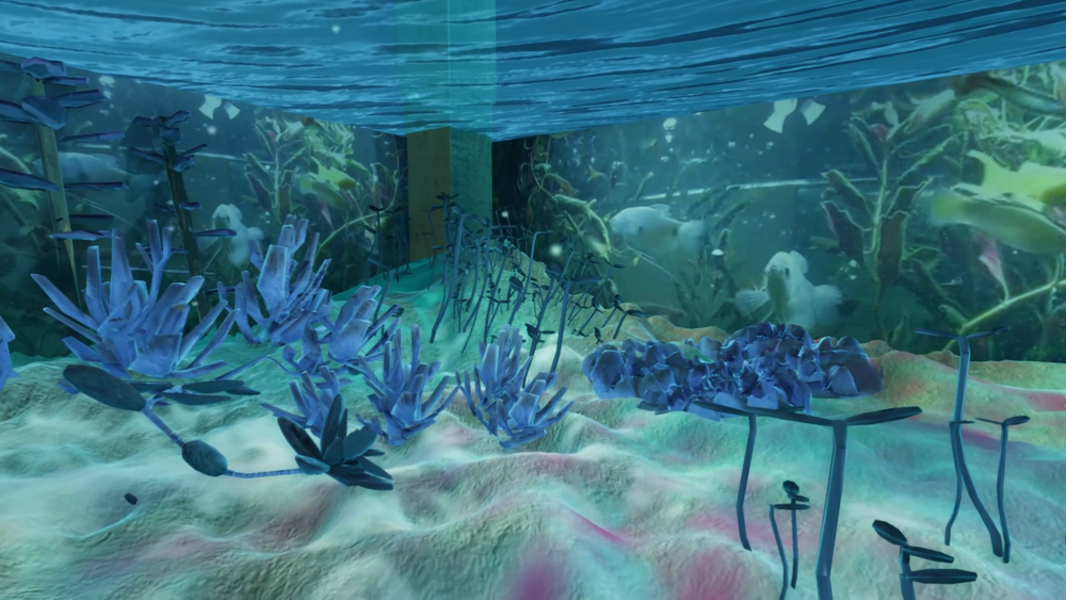 fishTank_A Coral Reef ◦ 2018Underwater, the user discovers a natural environment populated with tropical fish and imagined coral.
fishTank_A Coral Reef ◦ 2018Underwater, the user discovers a natural environment populated with tropical fish and imagined coral. -
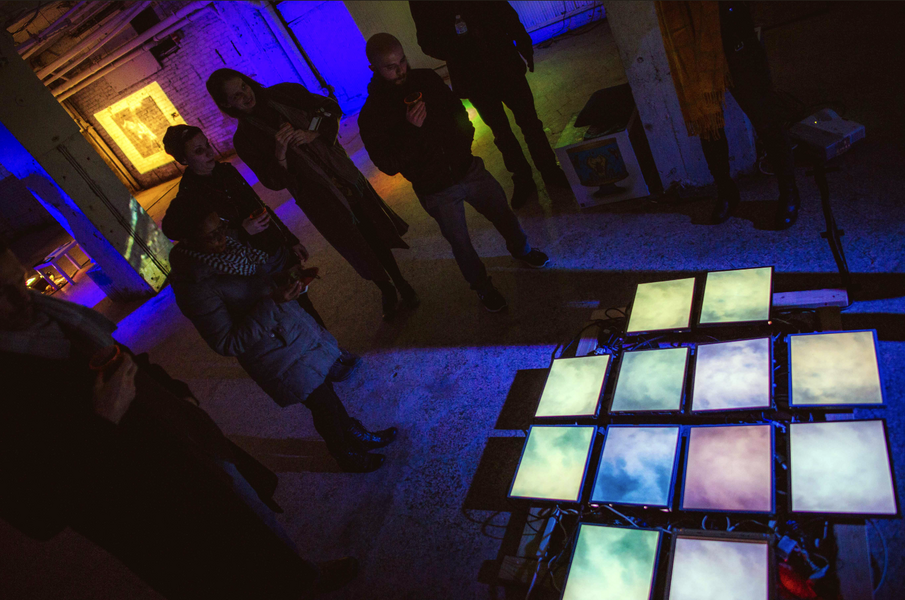 fishTank_sky ◦ 201812-Channel Video Installation ◦ 40 minute duration ◦ 12 monitors mounted on wooden rafters laid on the floor, showing captures from four videos placed underwater looking upward, each video feed duplicated and mirrored twice. Paper boats made from newspapers proclaiming recent unfortunate events sail over the view of an overcast day.
fishTank_sky ◦ 201812-Channel Video Installation ◦ 40 minute duration ◦ 12 monitors mounted on wooden rafters laid on the floor, showing captures from four videos placed underwater looking upward, each video feed duplicated and mirrored twice. Paper boats made from newspapers proclaiming recent unfortunate events sail over the view of an overcast day. -
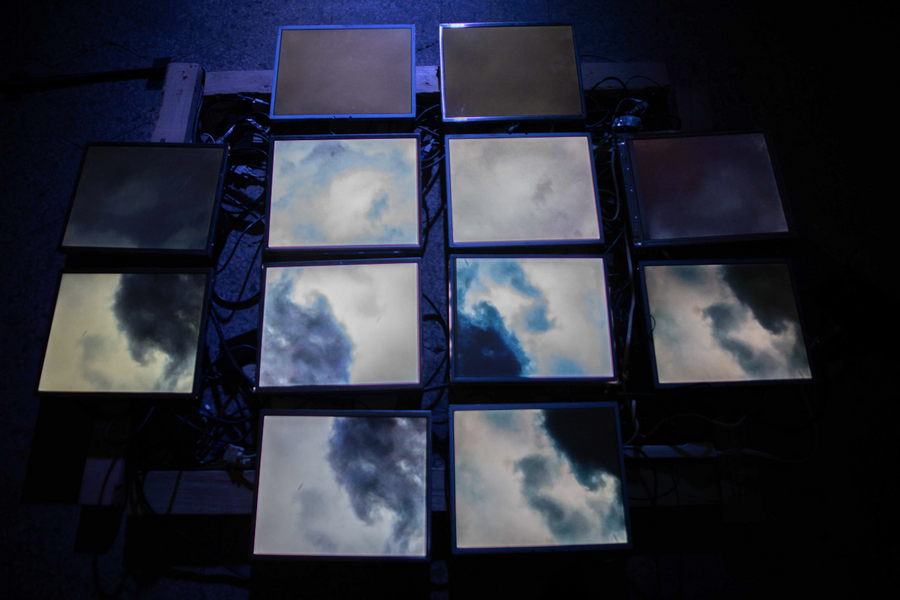 fishTank_sky ◦ 2018Paper boats made from newspapers proclaiming recent unfortunate events sail over the view of an overcast day.
fishTank_sky ◦ 2018Paper boats made from newspapers proclaiming recent unfortunate events sail over the view of an overcast day. -
 fishTank_flower ◦ 2018Small tanks and limited space can have negative effects on fish health and emotions.
fishTank_flower ◦ 2018Small tanks and limited space can have negative effects on fish health and emotions. -
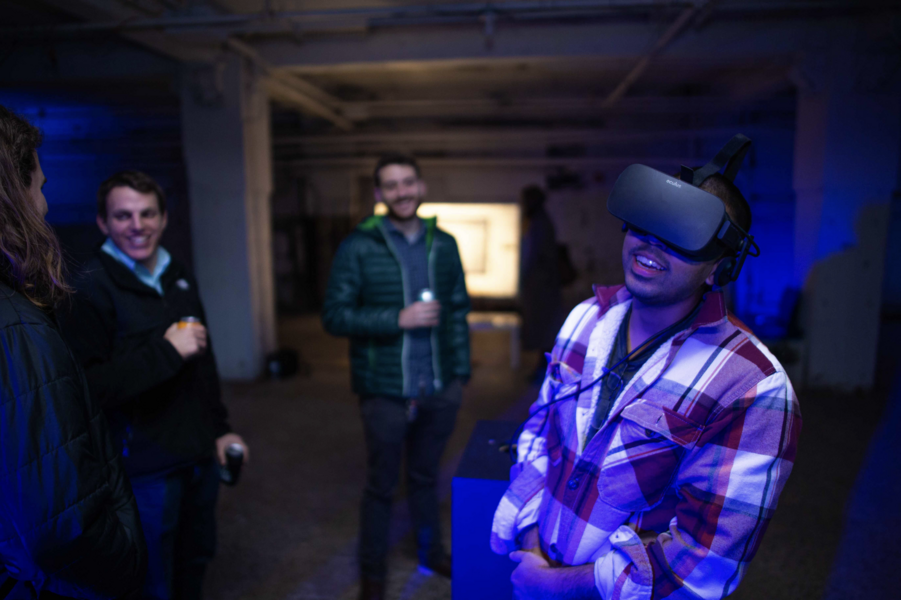 fishTank ◦ 2018Many species of captive fish will spend more time at the bottom of the tank, in a dark area if they are anxious.
fishTank ◦ 2018Many species of captive fish will spend more time at the bottom of the tank, in a dark area if they are anxious. -
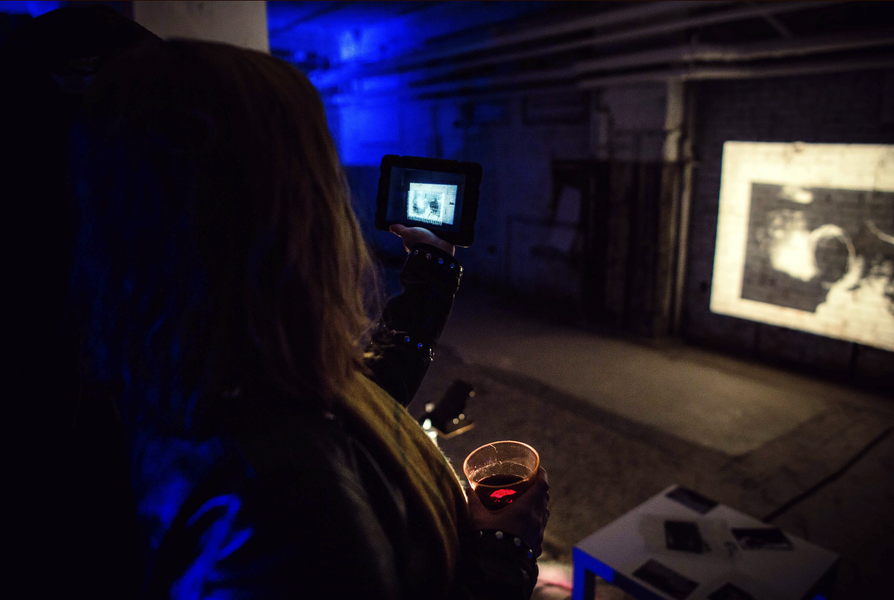 fishTank ◦ 2018A fish in a state of good welfare is more interesting to watch as it interacts with its environment.
fishTank ◦ 2018A fish in a state of good welfare is more interesting to watch as it interacts with its environment.
Christian Values
The Seminal piece for this project is "Omission" which is inspired by the Museum of the Bible's 2018 exhibition called "The Slave Bible: Let the Story Be Told." The Augmented Reality reveal on both the cover and final page of the "Omission" sculpture show a respective cover of 1807 publication "Parts of the Holy Bible, selected for the use of the Negro Slaves, in the British West-India Islands" along with a redacted title page to the Omission piece.
British missionaries used the 1807 bible to educate and proselytize an enslaved population. The editors removed 90 percent of the Old Testament and half of the New Testament. Among the excluded passages are Galatians 3:28, "There is neither Jew nor Greek, there is neither bond nor free, there is neither male nor female: for ye are all one in Christ Jesus", which was thought to possibly incite rebellion. Passages like Ephesians 6:5, "Servants, be obedient to them that are your masters according to the flesh, with fear and trembling, in singleness of your heart, as unto Christ," were kept. This bible at the Museum of the Bible exhibit was one of three copies of this version, and is owned by Fisk University. It was printed by Law and Gilbert of London, for the Society for the Conversion of Negro Slaves.
This oeuvre continues upon the narrative of edifice and ecclesiastical influences on 19th Century African American Education. The drawing is an ode to the educator and preacher, Daniel Coker, who founded African Bethel Church in 1816, while the photograph taken of the Haitian church, "Ansyen Catedral la" show, how very early on, the role that Christianity played in the African Diaspora. An augmented text reveal is displayed, whereas usually, the words are hidden until one looks at the image through the screen of a smartphone while the Renovations App is turned on.
-
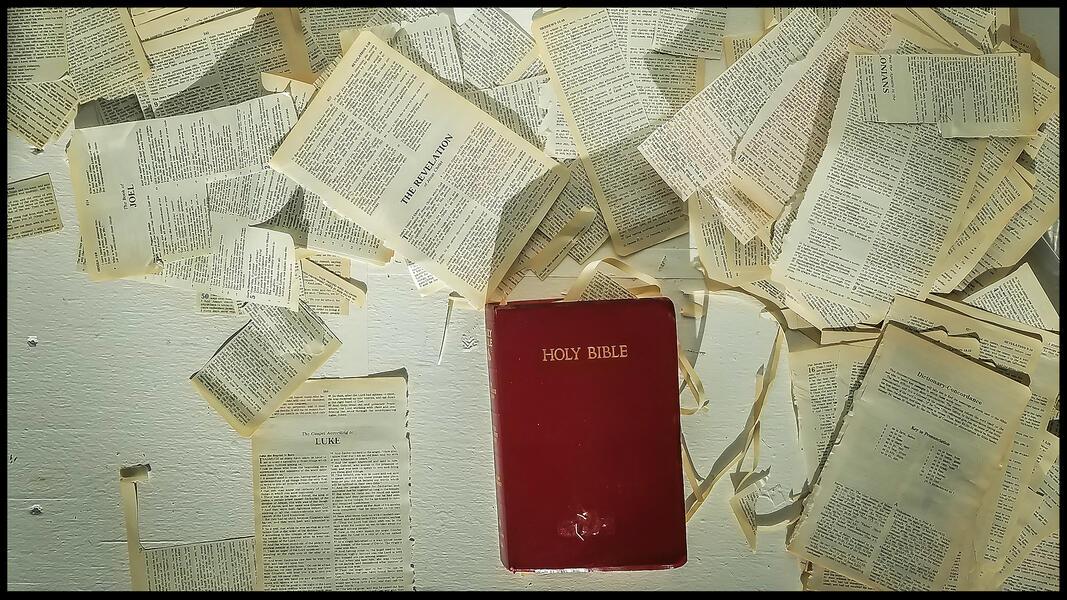 OmissionThe idea to cut an actual Bible was generated while considering what it means for any book to be redacted or misinterpreted. In this work, a King James version of the Bible is cut as a gesture towards the omissions of 'Parts of the Holy Bible, selected for the use of the Negro Slaves, in the British West-India Islands', which was originally published in 1807. Unlike other missionary bibles, the Slave Bible’s British publishers deliberately removed almost 90% of the book - basically any passage that could inspire hope for liberation. Instead, they emphasized portions that justified and fortified the system of slavery vital to the Empire. In the Renovations exhibit at the Carroll Mansion, a video played the 2 ½ hour performance of Omission. The artefact (the mangled book) was on display as two sections (what was and wasn't omitted from the slave bible) for visitors to leaf through.
OmissionThe idea to cut an actual Bible was generated while considering what it means for any book to be redacted or misinterpreted. In this work, a King James version of the Bible is cut as a gesture towards the omissions of 'Parts of the Holy Bible, selected for the use of the Negro Slaves, in the British West-India Islands', which was originally published in 1807. Unlike other missionary bibles, the Slave Bible’s British publishers deliberately removed almost 90% of the book - basically any passage that could inspire hope for liberation. Instead, they emphasized portions that justified and fortified the system of slavery vital to the Empire. In the Renovations exhibit at the Carroll Mansion, a video played the 2 ½ hour performance of Omission. The artefact (the mangled book) was on display as two sections (what was and wasn't omitted from the slave bible) for visitors to leaf through. -
Omission (excerpt)Omission | 2019 | (Full Performance : 2 hours 34 minutes) | So-called Slave Bibles included only selected portions of the Old and New Testaments. References to freedom and escape from slavery were omitted, while those encouraging obedience remained. In this work, the Bible is cut as a gesture towards the omissions of the slave bible. The 'Omission' performance took place in a former Methodist Church in upstate Vermont.
-
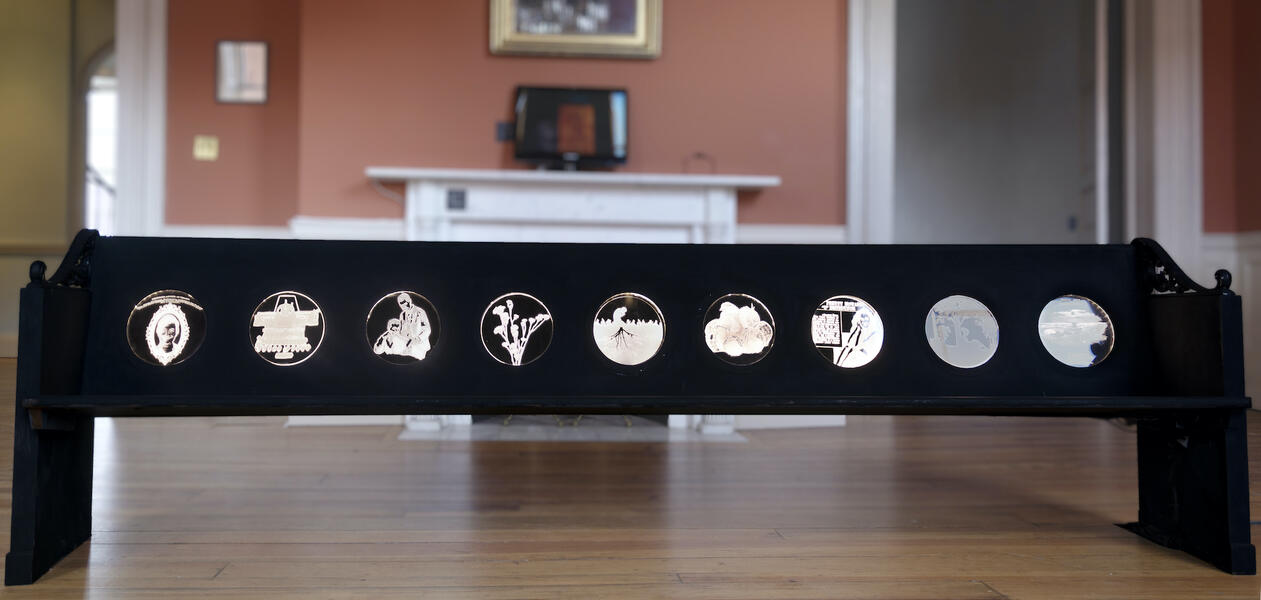 Ode to the Nine GraduatesAn Ode to the Nine Graduates ◦ 2020 ◦ 44 x 120 x 30 inch (h x w x d) ◦ Interactive Sculpture | Wood | Acrylic | LED Light This church pew is a call back to the connection between church and schools in the Black community. The earliest schools founded by Black community members were almost exclusively linked to Baptists, Methodists, and Catholic faiths. It was more than Sunday school and many students sat on church benches of the 19th century before desks had been incorporated into the classroom.
Ode to the Nine GraduatesAn Ode to the Nine Graduates ◦ 2020 ◦ 44 x 120 x 30 inch (h x w x d) ◦ Interactive Sculpture | Wood | Acrylic | LED Light This church pew is a call back to the connection between church and schools in the Black community. The earliest schools founded by Black community members were almost exclusively linked to Baptists, Methodists, and Catholic faiths. It was more than Sunday school and many students sat on church benches of the 19th century before desks had been incorporated into the classroom. -
an Ode to the Nine Graduates at the Old City HallSculpture w/ AR Application “The stage was set with flowers, and all the female pupils who occupied it were dressed in white. A chorus “Herd Bells” preceded the honorary address, “Songs of Shakespeare,” written by Nellie Anderson and read by Mamie Neale. The valedictory, prepared by Gertie Deaver and delivered by Gertie Anderson was upon the topic, “A Wonderful Factor.” The graduates were nine in number, and included seven girls and two boys. Their names are Gertie Anderson, Nellie Anderson, Gertrude Deaver, Fannie McCabe, Mollie Taylor, Violet Thompson, William Murray, Walter Scott and Mamie Neale.” Colored High School: First Diplomas. 29 June 1889. Baltimore Sun.
-
Ode to the Nine Graduates - the engravingsThe first nine graduates of the Peale Center each have a circular plaque dedication on this bench. Each plaque subtly distinguishes something unique about their lives. The augmented reality feature is incorporated in the bench design. The moon phases on the back of the bench relate the graduate ceremony motto "Through the Tempest To the Stars"
-
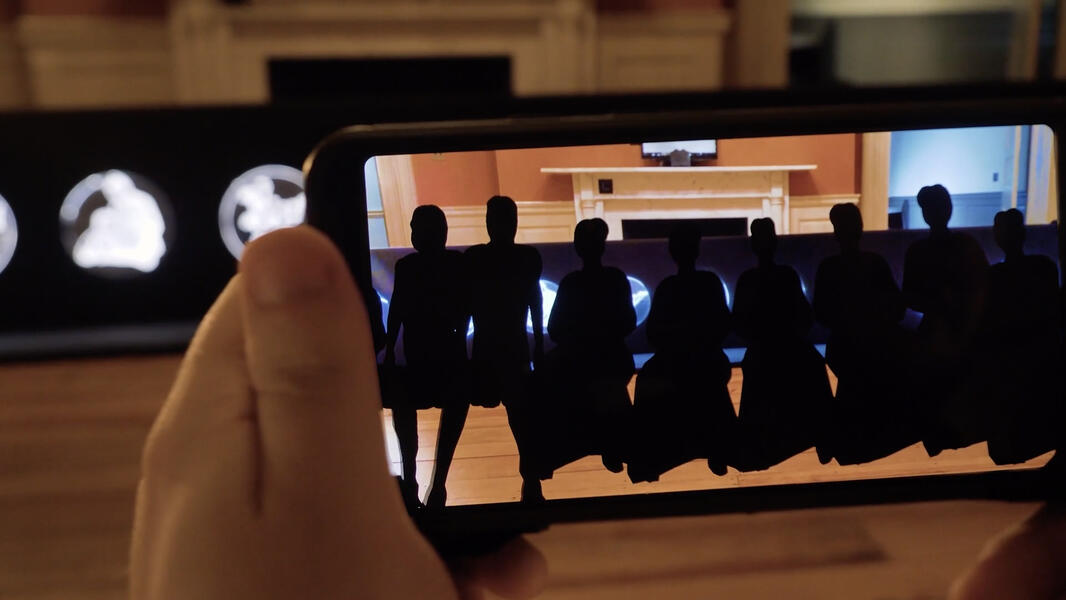 In Augmented RealityThis is a static view of the sculpture while in use with the AR app.
In Augmented RealityThis is a static view of the sculpture while in use with the AR app. -
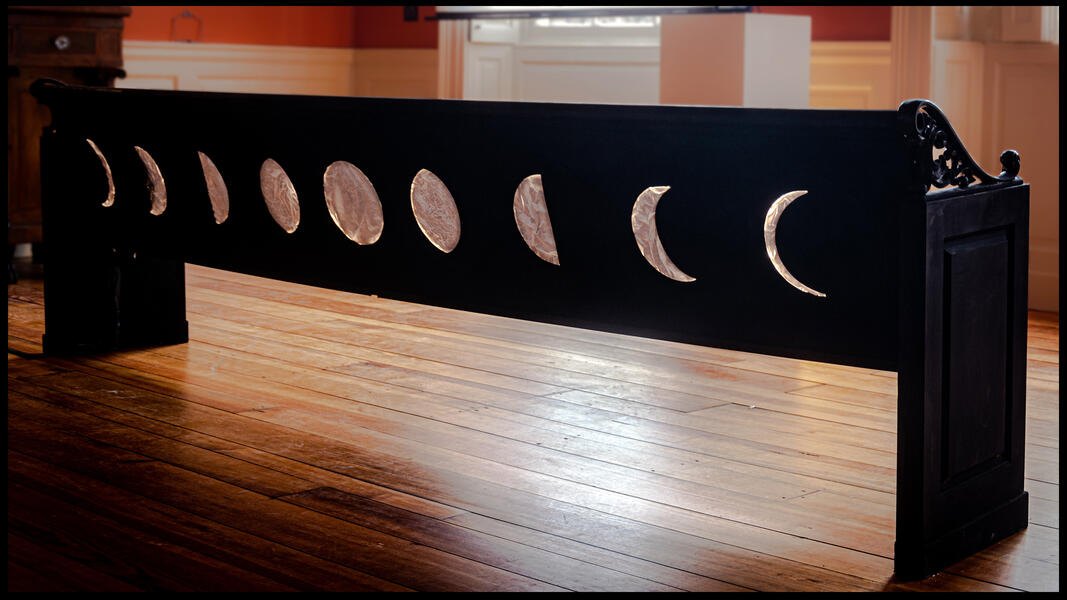 Ode to the Nine Graduates (alternate view)An Ode to the Nine Graduates (back) ◦ 2020 ◦ 44 x 120 x 30 inch (h x w x d) ◦ | Wood | Paper | LED Light
Ode to the Nine Graduates (alternate view)An Ode to the Nine Graduates (back) ◦ 2020 ◦ 44 x 120 x 30 inch (h x w x d) ◦ | Wood | Paper | LED Light -
Waves for Mother Elizabeth LangeVideo | 2020 | strikeWare filmed this video and took the subsequent photograph on an expedition to Haiti. The work pays an homage to Elizabeth Lange, who was born in 1784 in Haiti. Her parents fled Haiti during a revolution and went to Cuba, where Lange received her education. She came to Baltimore in 1813 and began to work to educate children of Caribbean immigrants and slaves, a practice which was illegal at that time.
-
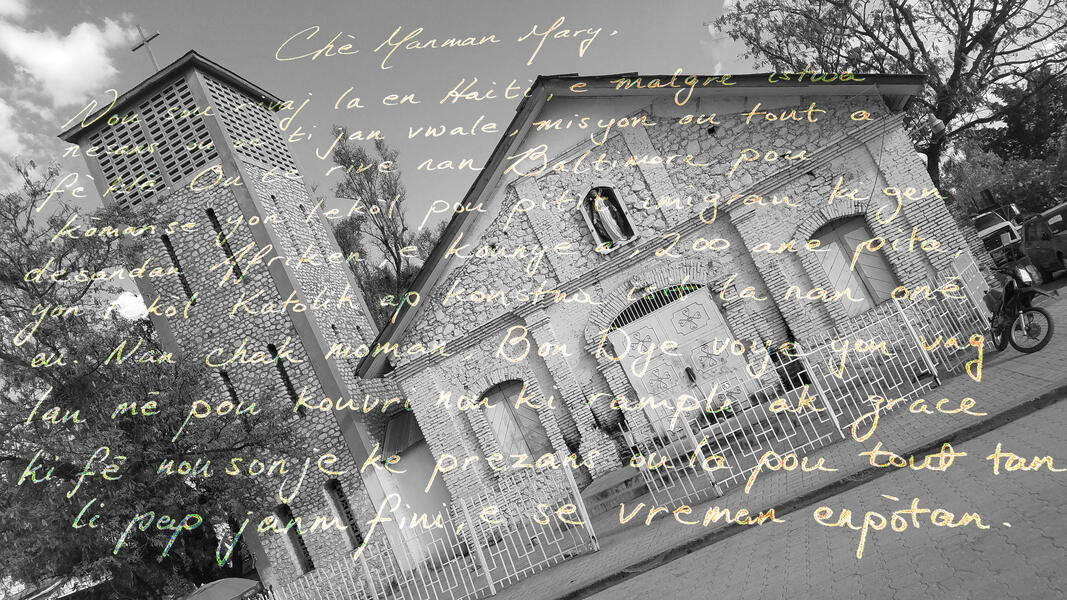 Ansyen Catedral La ◦ 2019This is the oldest church in the Western hemisphere and was photographed in 2019 by strikeWare member Christopher Kojzar. The translation to the Creole text revealed in the AR app is as follows: Dear Mother Mary, We are on the shores of Haiti, and although the history of your birth here is hazy, your mission was clear. You arrived to Baltimore to start a school for immigrant children of African descent, and now, 200 years later, a Catholic school is being built here in your honor. In every moment, a new wave of grace washes over us, gently reminding us that your presence is eternal, undiminished, and truly significant.
Ansyen Catedral La ◦ 2019This is the oldest church in the Western hemisphere and was photographed in 2019 by strikeWare member Christopher Kojzar. The translation to the Creole text revealed in the AR app is as follows: Dear Mother Mary, We are on the shores of Haiti, and although the history of your birth here is hazy, your mission was clear. You arrived to Baltimore to start a school for immigrant children of African descent, and now, 200 years later, a Catholic school is being built here in your honor. In every moment, a new wave of grace washes over us, gently reminding us that your presence is eternal, undiminished, and truly significant. -
Omission - a performance documentation alluding to the Slave Bible
Augmented Church & State
-
Augmented Church & StateView these images with the Renovations app to reveal additional content ◦ Available at strikeware.org
-
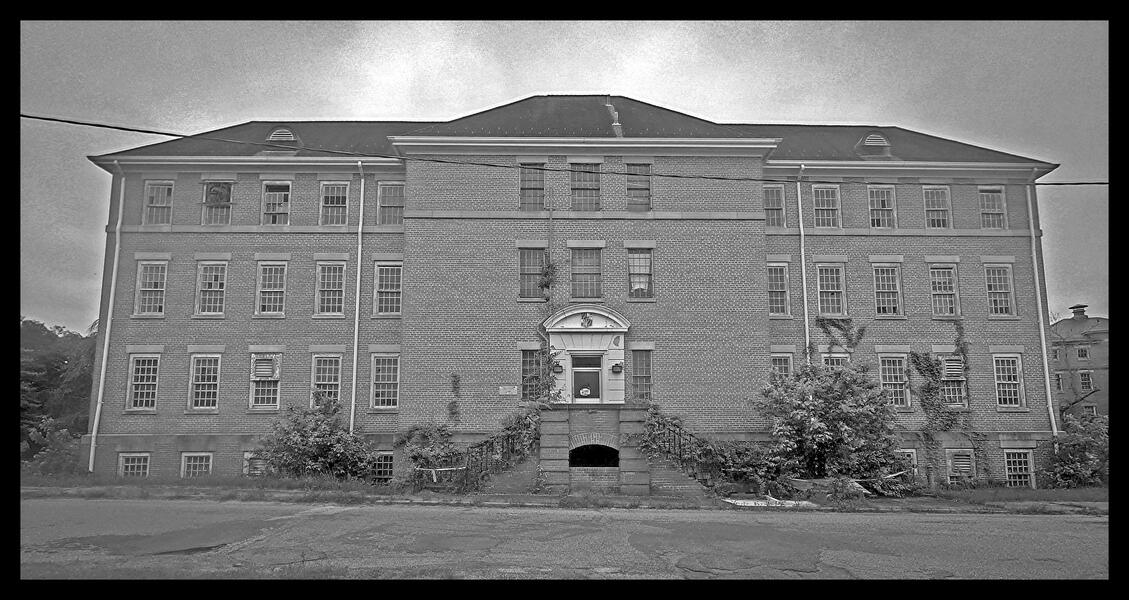 strikeCrowns ◦ 2020The Augmented Reality app reveals details of a verbal exchange which took place between a strikeWare member and a security officer in the spring of 2020.
strikeCrowns ◦ 2020The Augmented Reality app reveals details of a verbal exchange which took place between a strikeWare member and a security officer in the spring of 2020. -
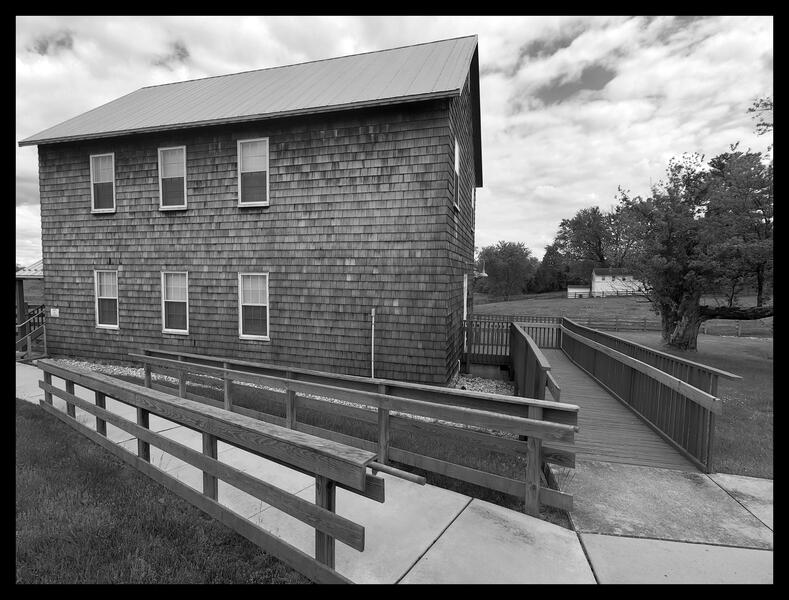 Hosanna Schoolhouse ◦ 2020“Our friends at H. [Havre de Grace], just before the commencement of the rebellion, built a school-house only to see it burned to the ground by the southern branch of the same clique who burned the colored orphan asylums and churches in New York." ◦ Edmonia Highgate, the first teacher of “Darlington School,” now known as Hosanna School in Harford County
Hosanna Schoolhouse ◦ 2020“Our friends at H. [Havre de Grace], just before the commencement of the rebellion, built a school-house only to see it burned to the ground by the southern branch of the same clique who burned the colored orphan asylums and churches in New York." ◦ Edmonia Highgate, the first teacher of “Darlington School,” now known as Hosanna School in Harford County -
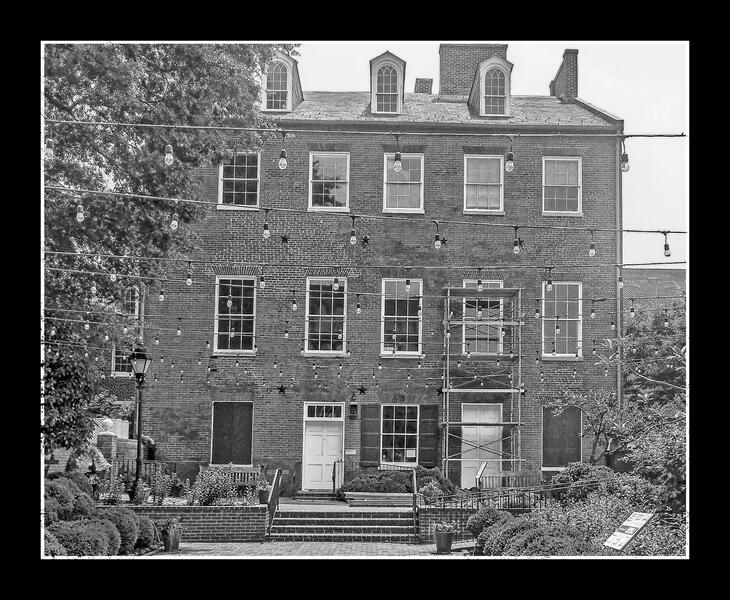 Carroll Mansion ◦ 2020The mansion holds a permanent exhibition about Charles Carroll of Carrollton, the mansion's first proprietor and one of the primary signers on the Declaration of Independence. Of the fifty-five men who added their name to the document, Charles was the only Catholic.
Carroll Mansion ◦ 2020The mansion holds a permanent exhibition about Charles Carroll of Carrollton, the mansion's first proprietor and one of the primary signers on the Declaration of Independence. Of the fifty-five men who added their name to the document, Charles was the only Catholic. -
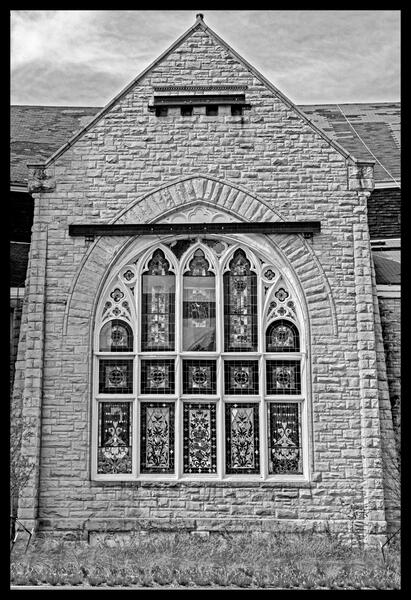 Calyborn Temple ◦ 2020By 2002, the church had already fallen into a state of near disrepair and was repurchased and re-institutionalized as the Historic Clayborn Temple on December 19th, 2019. The Historic Clayborn Temple recently succeeded in their multiphase fundraising campaign, raising $1.3 million to own and rehabilitate the building as a Black sacred space.
Calyborn Temple ◦ 2020By 2002, the church had already fallen into a state of near disrepair and was repurchased and re-institutionalized as the Historic Clayborn Temple on December 19th, 2019. The Historic Clayborn Temple recently succeeded in their multiphase fundraising campaign, raising $1.3 million to own and rehabilitate the building as a Black sacred space. -
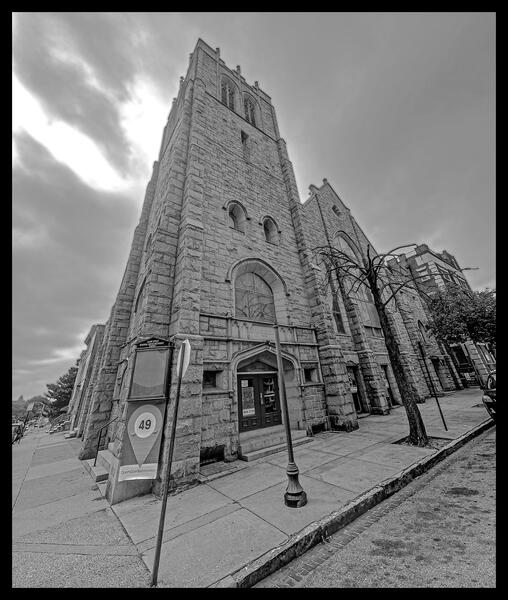 Present day Sharp Street Church ◦ Sharp Street Church of the pastView this image with the Renovations app to reveal additional content ◦ Sharp Street Memorial United Methodist Church began in 1787 and by 1802, the congregants had purchased their first building on Sharp Street between Lombard and Pratt. Rev. Daniel Coker began the African Academy, which in essence was a school for Black children.
Present day Sharp Street Church ◦ Sharp Street Church of the pastView this image with the Renovations app to reveal additional content ◦ Sharp Street Memorial United Methodist Church began in 1787 and by 1802, the congregants had purchased their first building on Sharp Street between Lombard and Pratt. Rev. Daniel Coker began the African Academy, which in essence was a school for Black children. -
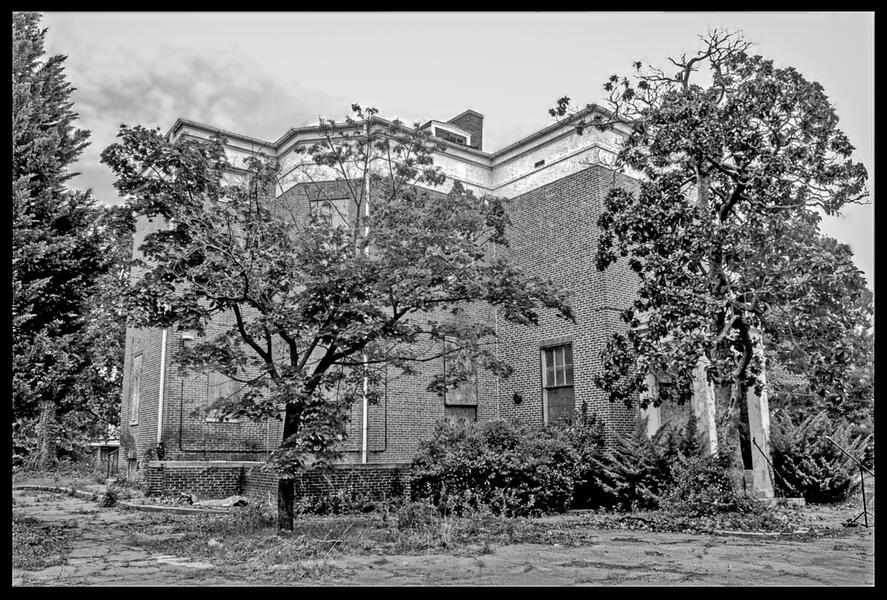 Upton ◦ 2020“Before the mansion was built in 1838 as the "country home" of Baltimore attorney David Stewart, who later served briefly as a U.S. senator, the property served as quarters to enslaved African Americans," states Dale Green (MSU). The mansion later became the Baltimore Institute of Musical Arts, an African American musical conservatory.
Upton ◦ 2020“Before the mansion was built in 1838 as the "country home" of Baltimore attorney David Stewart, who later served briefly as a U.S. senator, the property served as quarters to enslaved African Americans," states Dale Green (MSU). The mansion later became the Baltimore Institute of Musical Arts, an African American musical conservatory. -
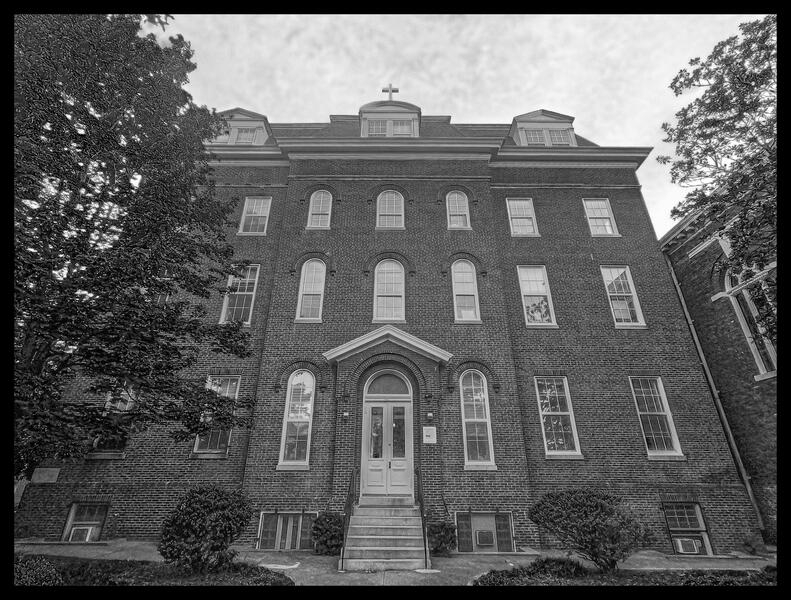 St. Frances Academy ◦ 2020St. Frances Academy is located on Chase Street less than a ¼ mile from the Baltimore City Detention Center. Established in 1828, it has been educating Black children in Baltimore for nearly 200 years. Its role has expanded into a co-educational program, a neighborhood gathering place, a community and health center.
St. Frances Academy ◦ 2020St. Frances Academy is located on Chase Street less than a ¼ mile from the Baltimore City Detention Center. Established in 1828, it has been educating Black children in Baltimore for nearly 200 years. Its role has expanded into a co-educational program, a neighborhood gathering place, a community and health center. -
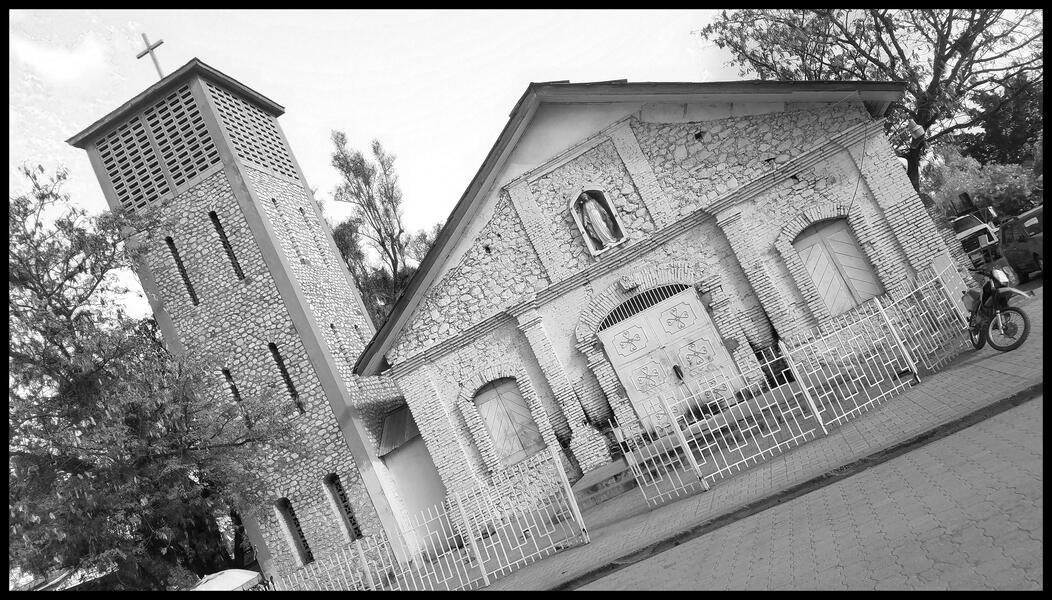 Ansyen Catedral La ◦ 2019This is the oldest Catholic church in the Western hemisphere and was photographed by strikeWare member Christopher Kojzar in 2019. It was built in 1503 by Nicholas Ovando, the first governor of the island known as Haiti.
Ansyen Catedral La ◦ 2019This is the oldest Catholic church in the Western hemisphere and was photographed by strikeWare member Christopher Kojzar in 2019. It was built in 1503 by Nicholas Ovando, the first governor of the island known as Haiti. -
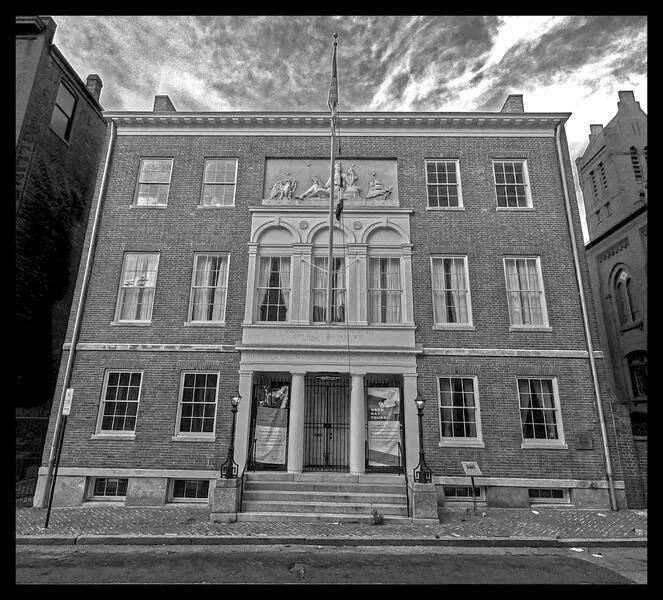 The Peale Center ◦ 2020The Peale Center building, known historically as “Male and Female Colored School Number 1”. While under renovations, their exhibits are housed in the Carroll Mansion.
The Peale Center ◦ 2020The Peale Center building, known historically as “Male and Female Colored School Number 1”. While under renovations, their exhibits are housed in the Carroll Mansion.
Clayborn Temple
-
ceiling of a Church ◦ 2020Interaction during exhibition display
-
ceiling of a Church ◦ 2020Ceiling of a Church ◦ (h-w-d): 40” x 26” x 20” ◦ mixed media sculpture | moving Image ◦ Participants are invited to gently dip their fingers in a shallow pool of water and move the chalk dust settled at the bottom to expose a rotating view of the Clayborn Temple ceiling.
-
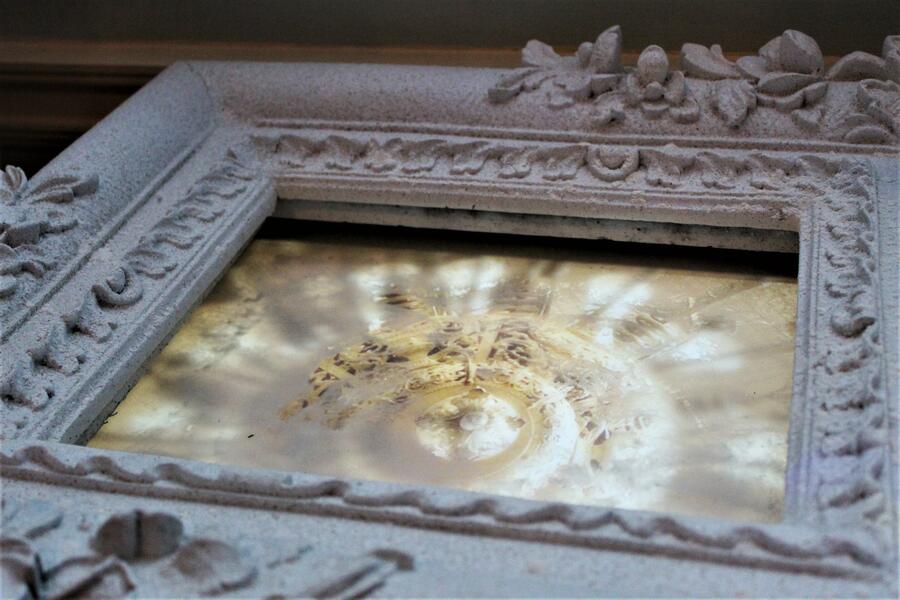 ceiling of a Churchalternate view
ceiling of a Churchalternate view -
another view of the Clayborn TempleInteractive Sculpture | (w-h-d) : 12" x 10" x 1/2" | 2020 | Participants are invited to hold the hands of the sculpted video display to look around a 360° video of the Clayborn Temple and listen to audio from the Sanitation Workers' I AM A MAN marches of 1968. Many buildings of significant importance to Black history remain in need of renovation. The Clayborn Temple played a critical part in the Sanitation Workers’ Strike of 1968. Marches to City Hall, most significantly led by Dr. Martin Luther King in the week before his assassination, originated at Clayborn Temple.
-
Augmented Church & StateView these images with the Renovations app to reveal additional content ◦ Available at strikeware.org
-
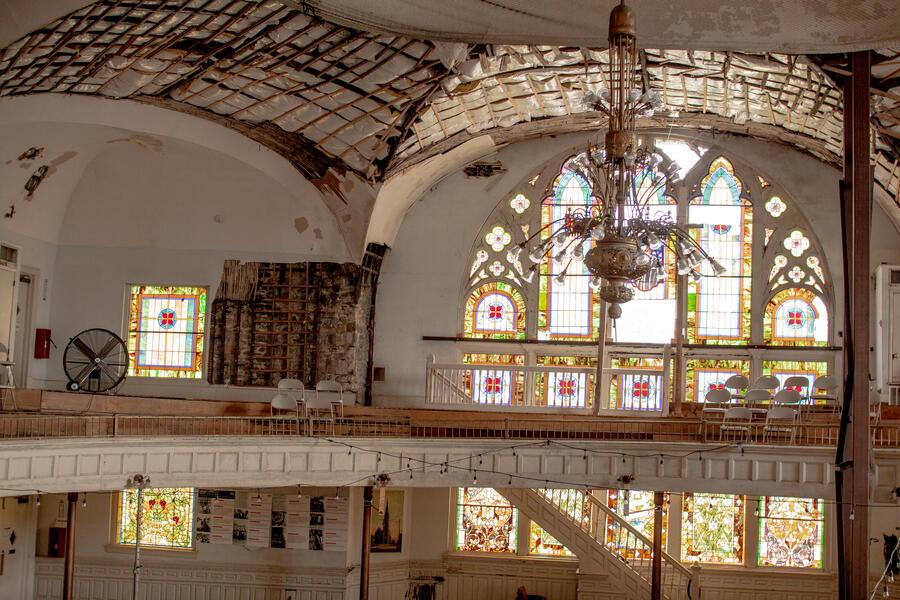 inside of a Church ◦ 2018
inside of a Church ◦ 2018 -
Clayborn Temple
-
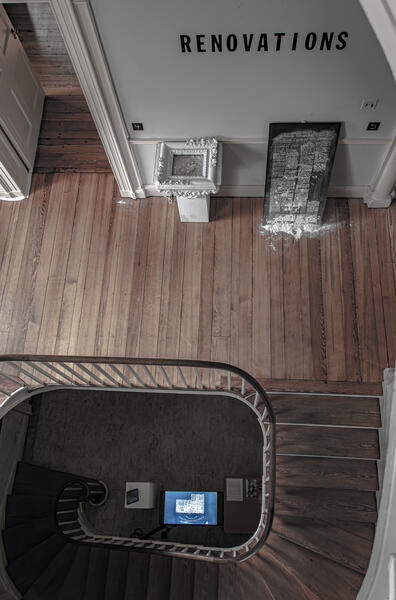 Birds Eye View of 'ceiling of a Church'
Birds Eye View of 'ceiling of a Church'
Baltimore Institute of Musical Arts
-
We’re Trespassing on these Grounds TodayWe’re Trespassing on these Grounds Today | Documentary Short | 2013 | Follows a local musician and a local resident as they dictate their personal research surrounding the Upton Mansion and its carriage house.
-
underWaterAR application Looking through the tablet up the stairs, underWater places viewers at the bottom of the ocean. After a time, a ship passes overhead. A 1949 recital from students at the Baltimore Institute of Musical Arts - an answer to the Peabody Institute’s refusal to integrate - plays in the background.
-
BIMA artWalkA walking tour from the former Baltimore Institute for Musical Arts to the Walters Art Museum in Baltimore, MD. The static document with supporting information may be viewed at the link "BIMA artWalk Document" in the Project Description.
-
An Interview Excerpt on BIMAThis is an excerpt of a 45 minute interview with life-long singer and performer, Daniel Comegys, who attended Baltimore Institute of Musical Arts.
-
Kunstmatrix Walk-through
-
Waves ◦ 2019This first version of underWater was incorporated in the Baltimore Museum of Art's 2019 exhibit Traces of the Spirit. This version, titled "Waves" shows a different animated ship with folk music sourced from John A. and Alan Lomax's catalogue of Negro spirituals (1933-1940)













